Earthdawn by dwarf74
History and an Overview
Original SA post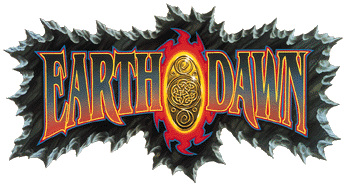
Part 1: History and an Overview
So. Earthdawn! If you were playing any RPGs in the 90's, it would have been hard to avoid hearing about it at least once, even if you've never played it. It was released in those tumultuous early 90's when TSR's market share was being steadily eroded by hordes of goths, and gaming companies started making enough money to put out quality competition.
Many gamers - myself included - were rather disaffected by AD&D at that point, whose 2nd edition was a few years old and (other than some neat settings) already stagnant. We were looking for something new and exciting. At the time, Earthdawn's publisher, FASA, was a behemoth. It grew fat off of the incredibly-popular Battletech, and its other major property, Shadowrun, was even popular enough for console games. As a result, FASA was in the rare position of being able to compete financially with TSR. So, seeing an opportunity, they made a direct competitor for AD&D. Yep, competitor. Earthdawn made no bones about its goal - it was D&D ... but fixed . Prepared spells? Monster-filled dungeons? Layers of hit points? It took those gamist mechanics and integrated them into the metaphysics and the setting.
I was in the long line at Milwaukee Gen Con 1993 where it was first released. I'd only heard about it the night before the Con, when I picked up a few free marketing brochures, full-color and attractively laid-out, with several sample characters and an adventure. My friends and I pored over them and tried to reverse-engineer the mechanics, and we were hooked more or less immediately. I knew I had to have it.
...Even though the cover? Well. Take a look.
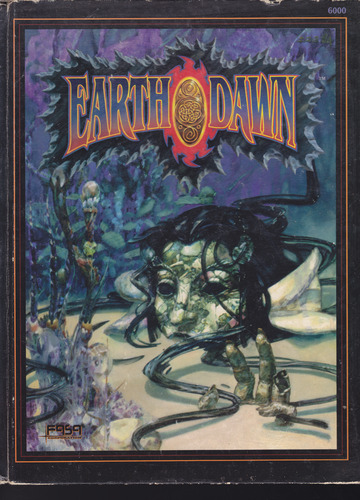
If it's a person, where are its eyes? If it's a statue, why does it have hair? ...and why is it drowning in milk?
I'm not saying the cover art is bad . It's actually pretty good. It's just entirely inappropriate. It's confusing and says basically nothing about what you should expect from the game. The new ones do better.
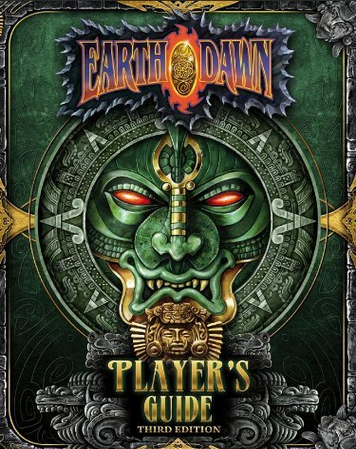
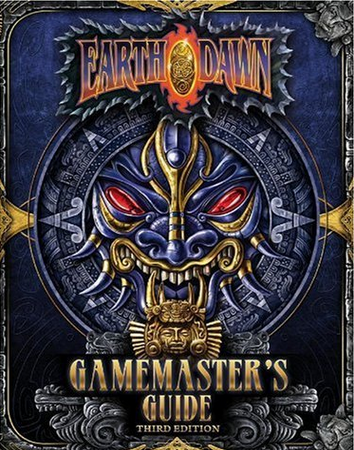
Not that they make much more sense, mind you. The setting is pretty much European, not South American as these would imply.
Anyway, I ran Earthdawn all through the remainder of my high school days, and ran campaigns over the various summers through college. I ran games for my grad school friends afterwards, too, with good results. I only jumped ship when D&D 3e was released, since that was (at the time) the new "D&D, fixed."
I still have a whole shelf dedicated to Earthdawn books. Along with my 1e AD&D books, they're pretty much staying with me forever.
Believe it or not, Earthdawn is still being published - and not as a retro-clone, either. But it has a long and tangled history. I'll let Wikipedia do my research for me...
quote:
...originally produced by FASA in 1993. In 1999 it was licensed to Living Room Games, which produced the Second Edition. It was licensed to RedBrick LLC in 2003, who released the Classic Edition in 2005 and the game's Third Edition in 2009 (the latter through Mongoose Publishing's Flaming Cobra imprint). The license is now held (again) by FASA Corporation through FASA Games, Inc., who have released the Revised Edition, a reformatting/rerelease of the now out-of-print Third Edition.
...So it was licensed to two separate companies, non-exclusively, had at least one fork of sorts, got a few new editions including two "Third Editions", and is now back to being published by its original publisher again, but just as a re-release of the last edition. Not only that, but it's been ... fecund.
You see, because Earthdawn is as much a setting as a system, here are editions of Earthdawn now for entirely different RPGs. The ones I know about are...
-
Earthdawn, Savage Worlds Edition
-
Earthdawn, Pathfinder Edition
- "Age of Legends" - planned for D&D 4th edition.
And for all I know, there's more.
Now, the 4e version was vaporware; it was never released, and likely was never at any stage of being finished. (And it will likely never be released, given 4e's sunset; it's a shame, a lot of 4e's concepts remind me of Earthdawn.) I've checked out the Savage Worlds edition enough to know that the designers had absolutely no clue how Savage Worlds works; it's the flavor text from every edition of Earthdawn alongside bafflingly dense mechanics - more a direct port than an interpretation. I've read that the Pathfinder edition is problematic as well, but admit no personal knowledge of it.
So basically... the property has been passed around like a hot potato. And given the history, I'm thinking it's generally failed to make any money or traction and it's being kept alive now as a labor of love.
-=-=-=-
OK, with that bit of the history out of the way, what's it all about? To make a long story short, it's kind of a "fantasy superheroes" game. Every character is an Adept. Adepts channel the magic of the world into a certain Discipline - basically a character class devoted to something like Archery, Swordsmanship, or Illusion. By tapping into the world's magic, they get better at their abilities very quickly and can summon up clearly impossible magical effects. Going with the "D&D Tropes as Metaphysics" theme, these Disciplines and Circles (think levels) are all concepts known by people in the world rather than a kind of metagame layer on top of it. It's safe to say there's almost no metagame, honestly, apart from the actual numbers and dice-rolling mechanics.
Like so many other 90's games, it's not just a system, it's a setting. And it's not just a setting, it's a metaplot . In this case, the setting is Barsaive, and although it's not really spelled out until later, it's basically the prehistory of Earth and part of the Shadowrun continuity. (The map is of a part of Eastern Europe, with a lava-filled Black Sea at the southern edge and Caspian Sea on the southeast.) The setting and mechanics are so tied together that it's hard to think of using Earthdawn as a generic system - quite intentionally so.
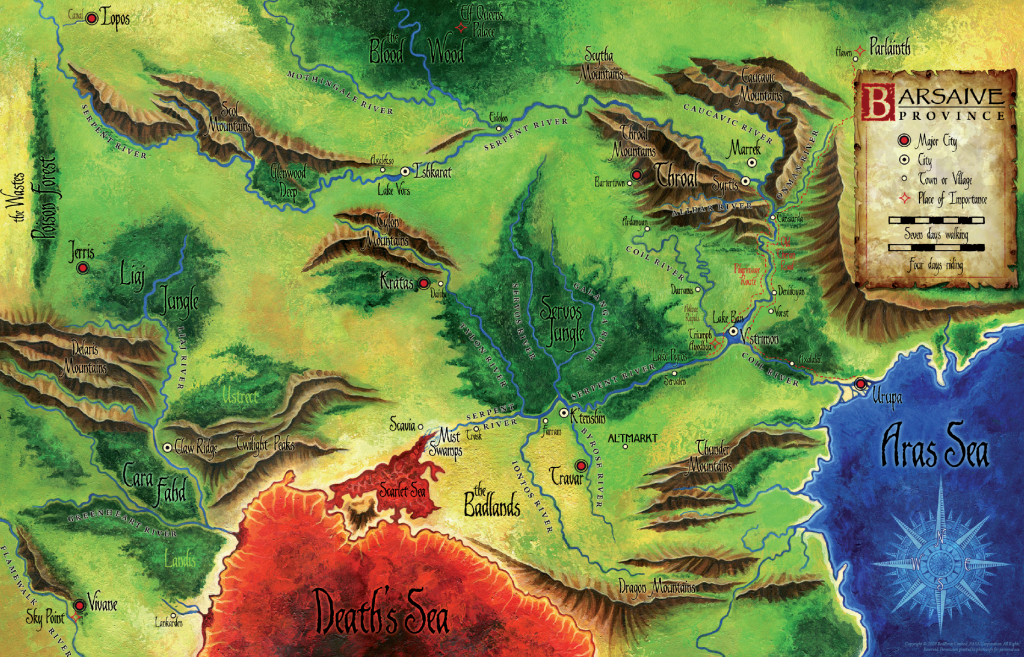
I mentioned dozens of supplements. Still having almost a full collection, I can state with certainty that many of the supplements wouldn't pass muster these days. At least three of them - two about the races and one about the disciplines - were about 130 pages of fluff and story, followed by 5 pages of rules. At least two or three releases had no mechanics whatsoever . (That's right! You just paid $20 for an 80-page book of short stories!) But ... this was the nineties! Full of storytelling! Mechanics are best stuck in a corner, somewhere buried deep in your book, if at all! And if White Wolf could sell almost system-free supplements, FASA wanted to, too.
In many ways, Earthdawn epitomizes the "90's RPG" stereotype. Not as much as Vampire, mind you, but ... well, here's the checklist.
-
Stories and history before any rules are approached (in the 1993 book, you go 44 pages before hitting a mechanic.)
-
Integrated setting and system, rather than generic system with several settings
-
Advancing metaplot, requiring continual buy-in to keep up
-
Said metaplot changes based on home game and convention play reports
-
An almost embarrassed approach to rules in some supplements
-
Crunchy mechanics which do anything
but
put story first
- A tendency towards a grey-on-grey morality, but (fortunately, IMO) tilted towards the heroic. No alignments, and most cultures are approached sympathetically. Orks aren't just for killing, in other words.
I'll be focusing mainly on the original 1993 release. I have the 3rd Edition core books, and I may poke into them on occasion to show some fixes, but Earthdawn suffered from some rather severe supplement bloat very rapidly, and instead of one 300-page book the 3rd edition is two 300 page books with much smaller fonts and incredibly shrunken whitespace . (It's nice because it incorporated many of the essential supplements, but also a bit intimidating. If I were to run Earthdawn today, I'd use the 3rd Edition rules, though - the patches and updates to stuff like karma and the step table are sorely needed.)
Now, much like Powers & Perils, I admit to a lot of fondness for this game, so it will be a bit hard to be cruel. I'm not impartial; I'm a fan. I have a lot more gaming under my belt than I did 20 years ago, though, and can already tell some of these mechanics are going to be a bear...
Next Up : Short stories, history, 90's bullshit.
The Stuff Before the Rules
Original SA post
Part 2: The Stuff Before the Rules
Earthdawn opens with a bang. A few of them, really. It's notable from comparing the 1993 and 2009 releases that the "fluff" is nearly identical between editions. That's because it's actually pretty good.
quote:
We live in an age of legend.
After centuries of hiding beneath the earth, humanity has ventured out into the sunlight to reclaim the world.
...
Once, long ago, the land grew lush and green. Thriving forests sheltered plants and animals, and people grew and prospered off the land's bounty. Then the Horrors came, and drowned the world in darkness....
It goes on from there, and I have to say it's one of the more effective and accurate setting treatments I've read at the front of an RPG. More or less, the sentient ("Name-Giver") races have just recently re-emerged from underground safe-houses called Kaers. Generations lived and died underground while the world's magic levels were high enough to allow Horrors to invade from the astral plane. These Horrors are seriously badass, as we'll find out. We also find out that the province of Barsaive is more or less in rebellion against a globe-spanning empire called Thera. Therans seem to consider everyone in Barsaive their slaves on account of showing them how to survive through the Scourge; the dwarf kingdom of Throal, on the other hand, has declared independence, and has outlawed slavery.
The combination of society just beginning to re-integrate, the threat of cosmic awfulness, and the political clusterfuck all lend themselves very well to an exciting setting. So, we're off to a good start.
It gets better, though. Earthdawn contains the best example of RPG rulebook fiction I've personally encountered - a short story called "Inheritance."
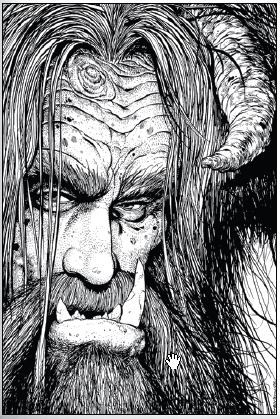
Lorm was a badass Troll
(Jeff Laubenstein's art is pretty fantastic throughout the book. It, too, has been preserved throughout the editions. I'd say his visual style is as much a part of Earthdawn as Brom's was to Dark Sun.)
It's fairly simple, and no work of high art, but it lays out the core concepts of Earthdawn very clearly and sets the tone very well. It's a tale of three adventurers - Lorm the Troll, Mestoph the elven Nethermancer, and Ragnar the dwarf Thief. They investigate a lost Kaer, quickly finding that it has already been found by a Horror.
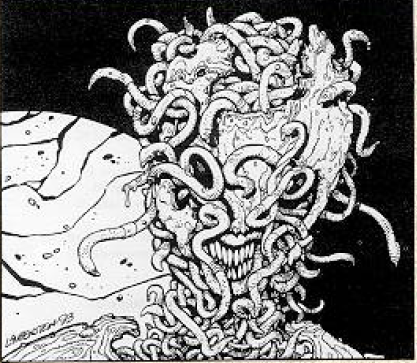
Warn your kids about spray tan before it's too late.
Well, without spoiling too much, he needs them to snag a golden shield for him - the one from the logo, funny enough. And although they put up a pretty good fight, the Horror establishes why he and his kind are fucking scary by doing this to the Nethermancer:
quote:
The Horror appeared next to Mestoph. His left eye-worm twitched uncontrollably as he reached out to touch the magician. Mestoph tried to dodge, but the elf reacted too slowly. A sucking, tearing sound came from within him and he began screaming. Then his hair whipped up and forward and his screams suddenly grew strangely muffled.
I screamed too, a dry, pitiful noise. I was staring at Mestoph's eyes and mouth, which were on the side of his face. The Horror had torn the skin loose from muscle and was shifting it around the elf's body.
Mestoph's blood did not flow so much as gush toward the Horror, transforming into burning white ribbons that wrapped around the entity. The Horror's triumphant screams drowned out our own.
...so yeah, the monsters in this game can SEPARATE YOUR SKIN FROM YOUR FUCKING BODY AND TWIST IT AROUND YOUR FACE.
The dwarf is the only one to survive this adventure, and brings Lorm's axe back with him. That axe, by the way, is one of the magic items in the setting - which I think is pretty damn cool.
Following this is a quite lengthy history in classic FASA style. If you know the Shadowrun history, you can guess at the style. It's a good read, but it leaves you with the impression that only a few important things happened each century. It all starts with Thera...
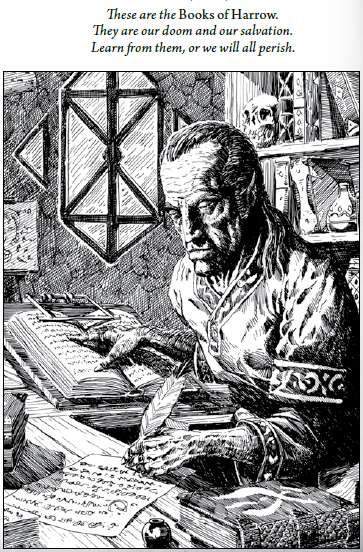
Thera gets its start with a bunch of bookish scholars. An elf, Elianar Messias (the Martyr Scholar) digs up some old books. Some really old books. In FASAworld, magic is cyclical, and these books seem to date from the last magic peak thousands of years ago. He starts translating them and ends up gouging his eyes out after leaving a warning - "These are the Books of Harrow. They are our doom and our salvation. Learn from them, or all will perish." His students set up a bigass library and get to work at translating.
A dwarf, Jaron, translates the first book. Basically, it says, "We're all fucked and will get destroyed by Horrors." The magic level rising is nominally a good thing - you can do neat stuff like run airships and blast shit with fireballs - but when it gets high enough, these Horrors can travel to the world and eat it. So, they set about looking for ways to survive the transition.
And that's how they form the Empire; they're basically the first IP lawyers. In return for a very reasonable "eternal obedience" they will happily describe how to protect your city/kingdom/village from the Scourge with the Rites of Protection and Passage. Therans start trading with Barsaive and pull a few tricks on the natives, so Barsaive is pretty much completely under Thera's yoke. Thera mines the living shit out of Barsaive's True Elemental and Orichalcum (valuable shit you need in order to survive the Scourge and make cool airships) and bombs anyone who resists.
And then TROLLS. Trolls in Earthdawn are kinda metal. They're basically huge, horned airship vikings who favor a lot of Living Crystal in their armor and weapons. They decide the Therans are easy picking. And they are - until the Therans bring out the big guns - mountain-sized airships called Behemoths. The trolls get decimated, sadly, but their culture lived on.
Now, some of the scholars who translated the Books of Harrow are still around. They're not exactly thrilled at this whole "Empire" bit and think the rulers are acting like enormous douches. One, Jaron - the guy who translated the first book - is still alive. He summons gigantic earth elementals who build a Sphinx right across from the central Citadel on Thera. He makes a big speech about the dangers of overreaching, and then disappears inside it. After which, it animates and stares straight into the heart of the building.
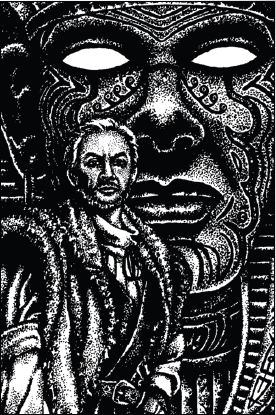
And that's why Thera has no Emperor, only Governors. Still, they basically shrug and keep on being dicks. As an example, a couple of immortal Dragons (who've been through a Scourge before) decide to start giving away their knowledge of how to survive it for free. Since this undercuts their prices, the Therans start killing said dragons, with some degree of success. And the dragons start killing the Therans back. This doesn't last long, and both sides basically back off.
Okay. So now let's talk about elves.
The Elf Queen, Alachia, tells Thera to fuck off. She further commands that none of the other elf nations should deal with them, and presents an alternative - basically a huge wall of wood. The other kingdoms more or less decline to commit certain suicide with her and deal with the Therans or others. However, Wyrm Wood - her seat of power and the center of elven culture - goes through with it. More on this in a few minutes.
Okay. Throal. I kinda skipped over this a bit. Throal is the largest kingdom in Barsaive, run by its most populous race: dwarfs (note the FASA spelling; also, it's awesome that dwarfs are the major race). They bought into the Theran plan but further improved upon it, hollowing out a huge mountain for their Kaer. What's more, they realized that these scholars and administrators hadn't given a single thought to life after the Scourge, so they compiled huge tomes called the Book of Tomorrow. It has the entire Dwarven language, practical knowledge, and (suspiciously left out of the Theran Rites of Protection and Passage) a way to figure out when the Scourge was over. They distribute this to every Kaer, and in the process pretty much successfully conquer and unite the entire region out from under Thera's eyes. (It's also an in-game explanation for a "Common Tongue" - another D&Dism, integrated.)
Then the Scourge happens. Thera seals itself off and everyone else decides that sounds like a good idea, too, on account of the Horrors starting to eat their brains. The Theran provincial capital of Parlainth actually removes itself from the world and memory. (This doesn't work so well.) The elves of Wyrm Wood build their silly little wood wall.
Yeah, that wall? Sucks. Horrors start chewing through it more or less immediately. The elves happen to notice that the really nasty Horrors don't go after people who are either insane or already in intense pain, and left with no good option, they undergo a ritual which causes thorns to grow under their skin and sprout all over their bodies, leaving them in constant, intense pain. The Horrors say, "Well, shit. Our work here is done, you lunatics!" and leave for saner pastures. And thus, we have the Blood Elves, also known as Thorn Elves, of Blood Wood.
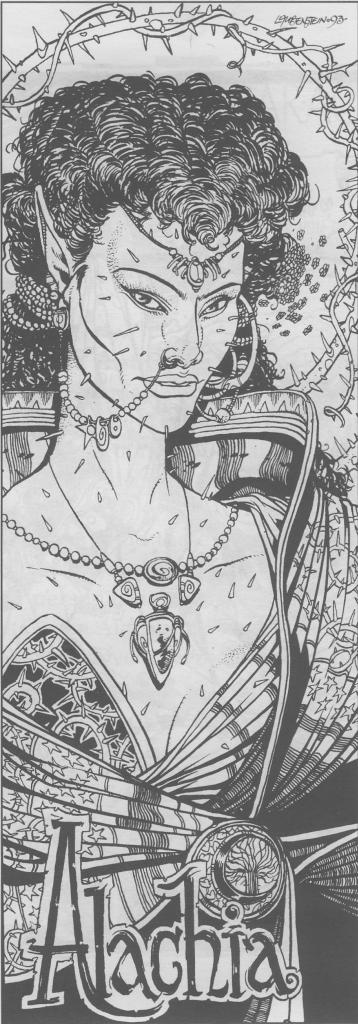
90's emo, in elf form!
Anyway, when the magic level mysteriously stops dropping, Throal decides to check things out. After a few lost missions, they send out a troll (see? trolls are awesome) captain and a ship called ... the Earthdawn (dun!). In a year, she returns and gives the all-clear. Throal has, in the meantime, put together a progressive Constitution that, among other things, outlaws slavery. They figure Thera was counting on a still-sleeping Barsaive, so they get to work welcoming closed-off Kaers back to the world and bringing them into their new nation.
The Therans start to come back, but after a few decades of freedom, Barsaive really isn't receptive to their "you owe us tribute and we rule you and can exploit your natural resources at-will" bullshit. So, they fight but the Barsaivians aren't really cooperating until Thera makes a really bad PR move. The First Governor of Thera has decided that the Throal constitution means everyone in Barsaive is his slave now because his extreme book-learning skills tell him that, and also, logic. That's the final straw, and everyone decides to work together to oust the Therans.
And that's where we are know. Thera is still a threat, with a strong military presence in the southwest. Throal opposes them. There are still Horrors here and there, and who knows what the dragons are doing. It's a good setup.
NEXT TIME : Races, or "Can I be a Rock-Man?"
Hey, It's a System!
Original SA post
Part 3: Hey, It's a System!
I had remembered the system getting buried further back in the corebook, but it turns out Earthdawn gets you started with some basic system-ish things right away. At its core, it's actually reasonably simple. As with all things, it will get more complicated down the road, but this part adequately covers the how-to-play stuff in a few pages, along with the obligatory "This is an RPG" sort of stuff.
You might expect, since the game's tied to Shadowrun, that Earthdawn might use the Shadowrun d6 system. Fortunately, this is not the case.
The heart of Earthdawn is the Step Table . If you love the idea of the step table, the rest of the game is fine. If you hate it, the game's a non-starter.
At its core, you're adding together an attribute and a Talent or Skill, then rolling against a target number. In most games, you have a die - say, a d20 or percentiles - that you roll, and add or subtract modifiers. Not so in Earthdawn.
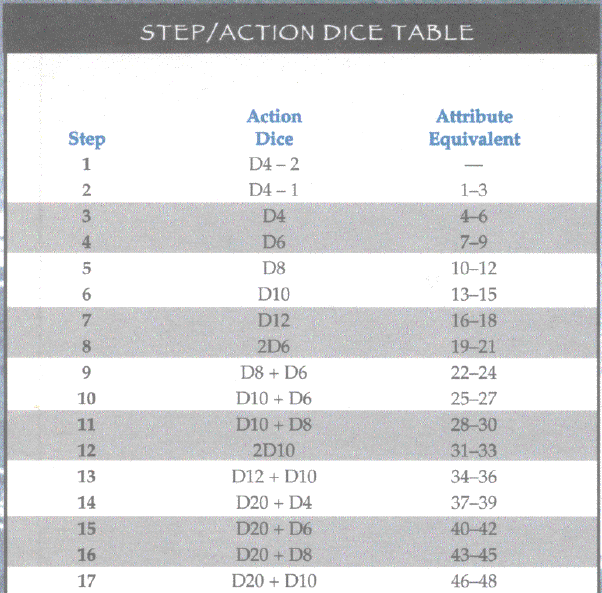
Here's how you use that beast. (And you'd better have it printed on your character sheet or kept handy for reference, because you're going to be looking at that table a whole lot.) Let's say I have a Step 6 Dexterity and Rank 2 in my Melee Weapons Talent. Adding these together, I learn I'd roll Step 8 for my melee attacks most of the time, or 2d6. (Yes, it might seem like Step 7, 1d12, is better. I'll get to this.)
However .
Let's say I have a modifier from something - maybe favorable conditions - which gives me a +2 to my attack roll. Instead of just rolling my 2d6 and adding 2, I take my Step of 8 and add 2 steps. So I'm rolling on Step 10 - 1d10+1d6.
It seems kind of slow and swingy, doesn't it? And yep, it pretty much is. Bonuses and penalties aren't guarantees of success against low target numbers; they're just greater odds of hitting them. Karma can even this out quite a lot - I'll cover it down the road when I talk about how absolutely screwed Obsidimen and Trolls are. It gets faster as you internalize the Step Table, but it takes a while to get less swingy.
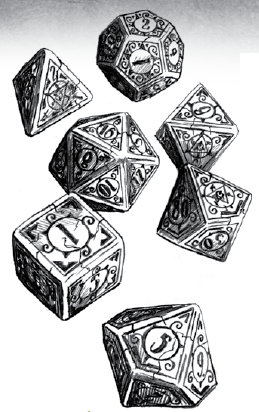
Does the idea of rolling all of these dice and adding them together sound appealing? Earthdawn may be for you...
Earthdawn has a few more quirks about die rolling, because this wasn't complicated enough yet. There's the Rule of One - if every die you roll is a 1, you fail. Period. And Bonus (aka Exploding) Dice - any die which shows its largest number is rolled again and added to the total.
Because of calculus, this means the Step Number is actually the average roll on your dice. It's also why 2d6 is considered better than 1d12 - first off, you're three times less likely to auto-fail, and every roll has a fair chance of at least one die exploding. (You also have a curve going for you, so you're less likely to fail easy tasks. On the other hand, it gets weird if your target number is 10 or 11, because probability is funny that way.)
But wait! There's more! If you beat your Target Number by a lot - it's generally around double, but not consistently so - you get an Excellent success. This does neat stuff like bypassing armor, so it's always good to be better at hitting. It's neat. And more complicated.
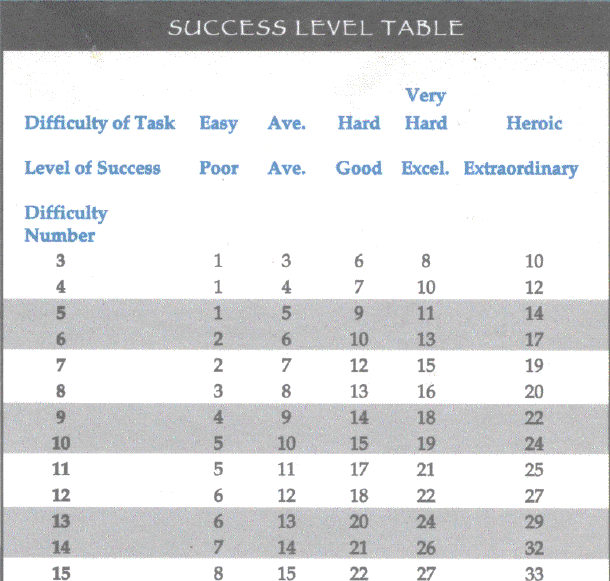
I am positive there's a pattern here, but it's too esoteric for me to pick out.
I want to go back to that Step Table real quick, because it gets wacky at places. Take a look at Step 14, for example, when d20's suddenly start getting added into the rotation. That works holy hell on your probabilities all of a sudden, because the swinginess of a d20 vastly outweighs anything a d4 or a d6 will do. So it's awkward and a little broken; a common houserule was to allow 2d12 instead.
So let's talk quickly about how Earthdawn 3e handles it, only in italics to let you know I'm talking about the newer rule set. Unsurprisingly, the answer is "better" but I'm fairly certain there are Earthdawn grognards somewhere who hate it. It only uses d6, d8, d10, and d12. I think removing d4's was probably unnecessary, but removing d20's was badly needed. You still have the weird Step 7 to Step 8 jump, but the situation is overall much improved and more stable. In fact, I'd recommend this step table to anyone even if you're running an earlier edition. Also, as an option, it presents the radical idea of adding bonuses and penalties from your base Step to the result of the roll rather than changing steps. Heresy!
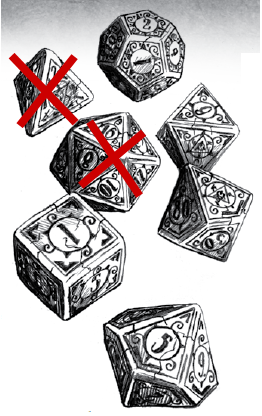
3rd Edition made a number of improvements to the rules.
(As a quick aside, when I got this book in 1993, this was like a lightning bolt. For one thing, even though I'd read a lot of RPGs, this is the first one which had me add dice of different sizes together. I know; kind of banal these days, but it was really appealing to me. Exploding dice, likewise, though I had seen them in other systems, too. The "changing steps" bit was also awesome; I had gotten tired of 2e's auto-successes. Nowadays, I still think it's clever, but the probability can get wacky.)
That's the meat and bones of this chapter, but it goes on to cover the other major concepts of the game in a kind of thumbnail sketch.
Earthdawn characters are all Adepts who belong to one of several Disciplines . You all use magic, even if you're mostly swinging a big axe around. This lets you sidestep a lot of weird training stuff, and lets you get awesome much faster than the populace. It's neat because, as far as I know, Earthdawn is one of the earlier traditional-ish fantasy RPGs to openly acknowledge that guys who swing swords should be able to do awesome stuff, too. (Of course, they handle it by giving them magic, which is kinda groggy, but it's still remarkably progressive for its time.) Your Discipline is basically your character class and world-view all rolled into one; there's some pretty complicated roleplaying stuff here which you can take or leave. Your Circle is your level, but (unlike D&D) it doesn't give you much directly. Earthdawn is mostly a Skill/Talent based game - most numerical advancement is done within the Talent system - including, if you can believe it, hit points.
Spellcasters use Spell Matrices , which let them cleanly channel astral energies without fear of getting burned up or eaten by Horrors. Magical power is woven into patterns and matrices using Threads . Adepts can use Blood Magic which comes in both "vaguely creepy" and "really disgusting" varieties, and which I'll cover later.
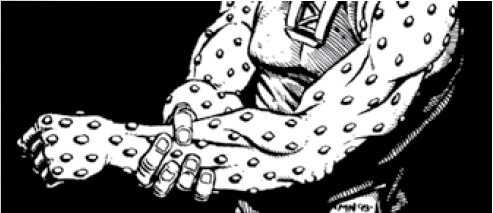
When you see "blood magic" it would not be wrong to think "cyborging"
You get better at stuff with Legend Points which you can spend either at self-improvement or on Karma . Karma represents your Adept's ability to channel magic into doing awesome things. If a Talent is central to your Discipline, you can spend a Karma point and roll your race's Karma die in addition to all the other dice you're rolling. (And yes, this die explodes, too.) The Karma system in ED 1e is vastly unfair. I want to mention this over and over again, because when I get to that part, I'll be able to tell you, "See?!?!"
And finally we get to Names. Names are an enormous deal in Earthdawn, tied with another major concept - Patterns. The sentient races of the world are called Name-Givers. It gets super-esoteric and way overcomplicated, and I'll cover it later on when we talk about magic.
Whew. Next time I'll post races, I promise.
Races
Original SA post
Earthdawn Part 4: Races
We're back to a "fluff" chapter, which is kind of annoying because right about now is when you start to need some rules. To this end, I'm going to skip around a bit to the Character Creation chapter and put the relevant bits here. The organization of the 1e book is pretty baffling... First you get the basic outlines of races, but if you want any mechanics, they're spread over the character creation chapter down the road in like 3-4 tables. I don't know if this was intentional or just a mistake; the 3rd edition book organizes it in a more sensible fashion.
There's 8 races; five should be familiar to anyone who knows Shadowrun ... or, um, any fantasy setting ever ... and the other three are brand new. The book points out it's dealing in stereotypes, and you should feel free to change stuff around for your character. But the racists in the game might treat you as if you were your stereotype.
As a quick note... One of the things I remember the most about Earthdawn is how deep the game gets into the races' psychology and culture. The thing is... that's nowhere to be found anywhere in the 1e core book. All of those details - including the really interesting stuff like liferocks and gahad - were in later supplements. In fact, going just by this book alone, you could fairly say that Earthdawn's races are almost universally dull.
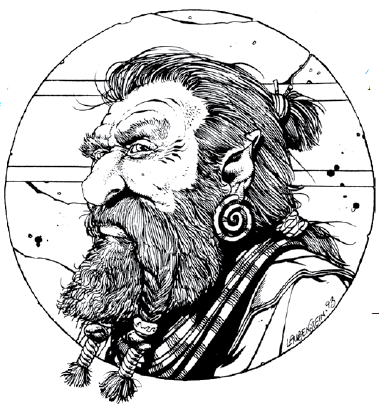
Frankly, that's a pretty sweet dwarf. FYI, piercings and tattoos are kind of pervasive.
Dwarfs (FASA doesn't use the Tolkienized "Dwarves" for whatever reason) are kinda-sorta familiar. They're still tough and strong, and not altogether charismatic, but they are stuck at the bottom of a wide field of strong/tough races. They tend to be both civilized and a bit on the bookish side; you still have your armorers and weaponsmiths, but dwar
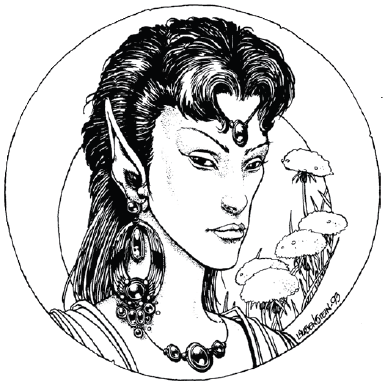
Their picture even looks boring
Elfs - I mean Elves - are dull stereotypes. Graceful, beautiful, lithe, love woods, cultured... :blah: Basically, take every elf ever, remove anything interesting, and that's the Earthdawn "normal" elf. Oh, they can be funny colors, but ... blah. Blood Elves aren't PC races for what are probably very good reasons of them being insane and awful.
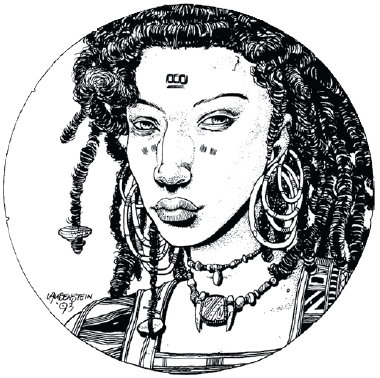
You can instantly recognize a Laubenstein by those noses...
Humans are, hilariously, described just like any other race. It notes their drive and ambition, and also how they tend to be pretty aggressive by and large. They're really social and don't mind using Dwarven (Dwarfish? I have no clue) inventions like ... cities.
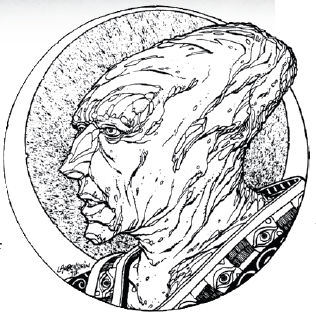
Beldar! I summon you to consume mass quantities!
Obsidimen are by far the most unusual race in the setting, and they pretty much confused everyone until a bunch of material was written for them in Denizens of Barsaive II. They're basically big, sentient, living rocks with something like flesh under a hard mineral coating. They are incredibly strong, incredibly tough, and incredibly slow, and live up to about 900 years. (So there are still some Obsidimen around who lived through the Scourge.) There's mention of something called a Liferock, but it's not detailed much. They also hibernate if they're kept underground too long, which is kind of funny. They are the toughest and strongest of the four tough/strong races, but they are also a trap.
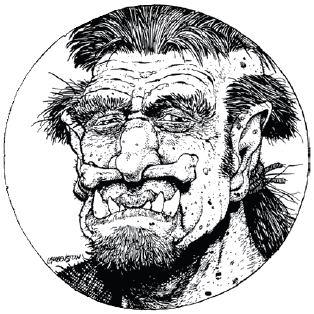
They even look like smaller Trolls.
Orks (the K is another FASA-ism) are an aggressive, short-tempered, near-human race. They get interesting, but here that's about all they have. They have one of the better backgrounds, too - they suffered under the yoke of slavery much worse than most races, and not just from the Therans. They tend to be nomadic and tribal, which is barely alluded to here. I'll talk about their gahad later, but it's absent from the core rules. More or less - they have one or several triggers ("Never insult my mom!") and they can either destroy the trigger or suffer by swallowing their rage. As it stands, though, they're just smaller trolls.
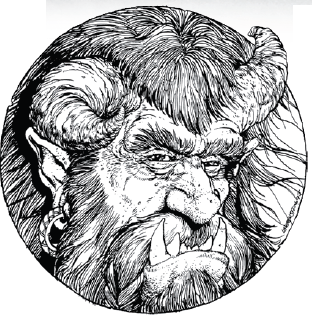
I have yet to see an Earthdawn troll picture where they don't look badass.
Ahh, trolls. My sentimental favorites, though almost as much a trap as obsidimen. Trolls are over eight feet tall, covered in bony protrusions (that give them no armor) and body hair, with serious rage issues. They also have the "honorable warrior race" thing going for them, which may have been more interesting in the 90's. They are fiercely loyal to their family and clan, and also think Obsidimen are awesome.
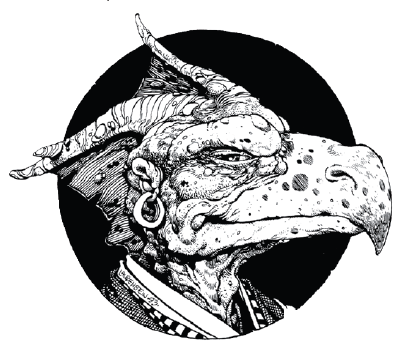
Give them credit: You can look at this picture and understand the race.
T'skrang are another new race. Although lizardmen have been done before, I think this is the first time they've been river-boatmen who all dress garishly and act like Errol Flynn. They're a race full of flamboyant swashbucklers, one part Jack Sparrow and one part Three Musketeers. They love their tails, too - their tails are very important. An entire Discipline - the Swordmaster - is more or less made specifically for them. It also has the worst gaming book prose I can remember. "T'skrang consider members of the other Name-giver races dull and boring. In turn, most other Name-giver races consider T'skrang overly flamboyant and somewhat frivolous. All races agree that each has a unique and necessary place in the society of Barsaive, so agree to disagree "

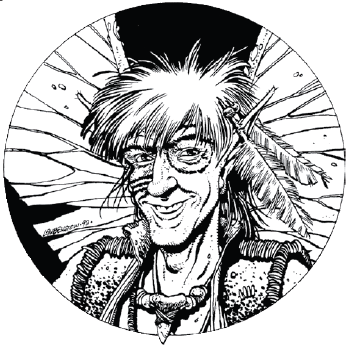
Yep, even the pixies have tattoos.
Alright, so who thinks it's a good idea to take Kender (minus the kleptomania) and put wings on them? Quick show of hands ... nobody? Nobody at all? Does it sound a bit too much like the punchline to a "Just when you think things can't get worse, remember..." joke? Well, too bad, because that's basically what Windlings are - mischievous trickster sprites 18" tall who fly and annoy people. I really, really question if an 18" tall character should have even remotely useful Strength and Toughness scores, but there you have it.
So let's talk mechanics. We have three full tables of them. We'll start with this one:

Okay, so I haven't gone over stats yet. But if you know D&D, you know basically how they work. The important things to keep in mind are that Dexterity , Perception , and Charisma are your primary "Doing Stuff/Not Getting Stuff Done to You" stats, while Strength and Willpower are your "How Well you Do Stuff" stats. Toughness is something you just want, for obvious reasons, no matter who you are. Dexterity and Perception are the biggies, though - the former is all your melee and missile attacks; the latter is your spellcasting.
So all those huge stat bonuses? Usually in Strength/Toughness. It's not like it's bad to have them, but they help less than you might expect. If you see the Obsidimen's Dexterity penalty, you might start to see the jaws of the trap, set and ready to spring.
It doesn't take a genius to notice that some of the races - Windlings in particular - get kind of hosed, stat-wise. Most races have more bonuses than penalties, with Humans and Orks pretty well balanced. That's where Karma comes in. In theory.
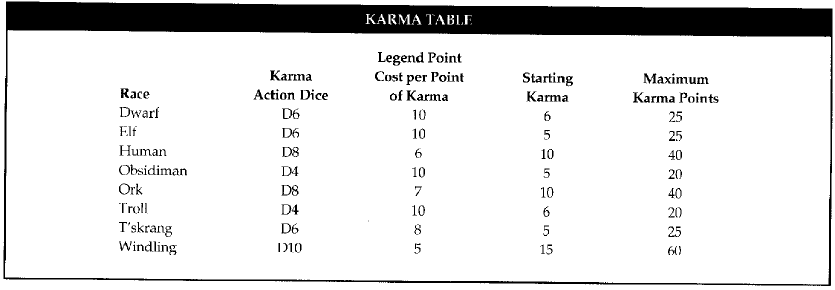
Okay. This will require skipping ahead a bit, so you don't know this when making your character, probably. Briefly: when you're doing a task central to your Discipline - like Ranged Weapons for Archers or Spellcasting for Elementalists - you have the option of spending Karma to improve your chances. You can only get so much of it every day, limited by a Talent called your Karma Ritual. And it eats up what are basically your experience points when you want more.
So as you can see, Windlings (being hosed in the stat department) get d10 karma dice and buy it incredibly cheaply. Obsidimen (with their mighty bonuses to less-important statistics) get d4 karma dice, can never get much of it, and buy it at a premium. Elves, Dwarfs, and T'skrang do alright , but Humans and Orks rock right along almost with Windlings.
So that's where the cosmic unfairness really starts to hit, and why Trolls and Obsidimen are traps - and obsidimen a bit moreso, with their Dexterity penalty. The rebalancing mechanic ended up swinging the pendulum waaay in the other direction.
If your Obsidiman Warrior (because of course you want to be a Warrior) has a 13 Dexterity, it cost him a premium to get there. With a Melee Weapons rank of 2, he's rolling Step 8, or 2d6. If he's going after something that's hard to hit, he'll want to spend Karma ... which is a whole freaking 1d4 , so it's rarely much help at all.
So what it comes down to is that your stats are often pretty unimportant, and spending Karma is both common and often necessary. If you have a good Karma die, at low Circles it can often swing your Action Dice a whole lot. If you don't have a good Karma die, it won't. Think about it this way. If you're an Obsidiman you can get +3 to your attacks on occasion. If you are an Ork, you can get +5 to your attacks regularly.
And your awesome, beefy Obsidiman Warrior can't hit worth shit and his Strength is essentially worthless.

You fell victim to one of the classic blunders!
Oh yeah. Windlings are so hosed, stat-wise, they get 1d10 for their Karma dice. They get this because their Strength is awful, mainly. Man ... I can't imagine what sorts of characters could afford to sacrifice their Strength and Toughness ... Do Windlings have anything else which could help them stay out of trouble?
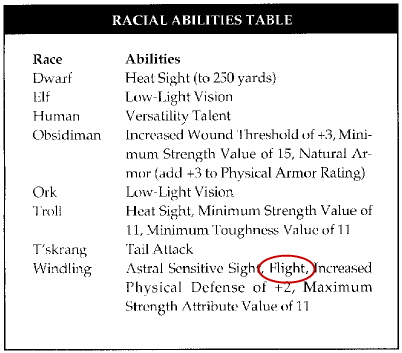
Ohhh yeahhhh....
So your windling spellcasters, who are just fine in every stat they care about, can both fly and also get an extra d10 - that's basically +6 Steps almost whenever they want to do anything, because 5 legend points is dirt cheap.
Okay. Karma rant over. The last time I ran Earthdawn, though, this turned out to be a major hassle.
Earthdawn 3rd edition corrects this, mostly. First off, everyone rolls a d6 for their karma die. And it costs 10 Legend Points for everyone. High-karma races can "store" more of it than low-karma races, but that's it. Windlings can still build up a hefty reserve of karma pretty well, but it at least costs them the same as everyone else. It also broadens the number of Talents you can spend karma on; this is cool, too.
Going back to the racial ability table... There's some boring stuff there (infravision, low-light vision, blah), some actually really good stuff (mostly for obsidimen and windlings), "tail attack" which is lame under Earthdawn 1e rules, and ... Human Versatility.
Doing a 180 from AD&D, Humans in Earthdawn are the most versatile race, not the least. Their Versatility talent lets them (at a cost) pick up Talents from other disciplines. Usually this is just for a small bit of effect or flavor ... unless you happen to be a spellcaster. Humans make the most versatile spellcasters in the game, by wide margins. I'll go over this later, though. Suffice to say it's a pretty good bargain in a lot of cases. Ironically, this also makes Humans the hardest race to play effectively.
And that sums up races. Next up? Making a character. And I will make a troll anyway.
Skipping Ahead to Disciplines Because That's Something You Need to Know Before Making a Character No Matter What Order the Book Has Them In
Original SA post
Part 5: Skipping Ahead to Disciplines Because That's Something You Need to Know Before Making a Character No Matter What Order the Book Has Them In
First off, a note: I had forgotten about the CD! Back when FASA was struggling to make Earthdawn happen more, they basically took the nuclear option and released the entire core rulebook and some other information, for free, with a magazine issue. (Anyone remember Shadis? Nope, me neither.) They hoped this would drive rulebook sales, but ... well, it still tanked anyway.
Yeah, so my goal for this post was to make a Troll. That's still the goal. But before doing that I figure we'd better talk Disciplines.
As I've mentioned, your Discipline is basically your character class. It's more than that, though - it's a metaphor for how you see the world. The examples are "A Troubadour sees the world as a grand stage on which he can perform, while a Warrior sees the world as a vast battlefield on which he can fight for the causes he supports." If your players are game, this is actually pretty cool, and adds yet another setting difference between Earthdawn and basic fantasy. Another thing to keep in mind? Every character in Earthdawn uses magic. Not necessarily as spells, but still magic. Yes, this includes the Warrior and Swordmaster... We can get to that later.
There are 13 disciplines in the core book. More were added over the product's cycle, including most of the really neat or unusual ones like Ork Liberator, Obsidiman Purifier, Troll Outcast Warrior, and Horror Stalker. The ones presented here tend to be fairly generic, though there's still a few surprises here and there.
One thing of note - the Disciplines in Earthdawn 1e are excessively straitjacketed, even for Humans. Each one's Talent list is very inflexible, and ... well, read on, because even Humans' Versatility Talent is no great help, in most cases.
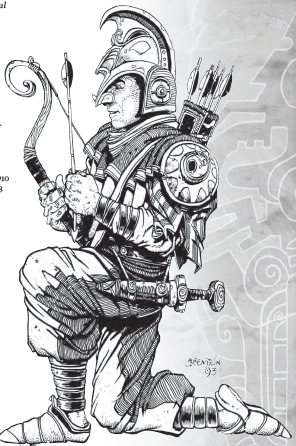
Archers are a distinct class in Earthdawn rather than a specialization for a more generic class like Fighter or Ranger. Their main attributes are Dexterity and Perception. This is a really neat, thematic Discipline. In addition to the normal "shooting stuff" talents, they can dodge attacks, create a magical laser sight, find people by shooting an arrow up into the air, and fire intensely accurate shots that can drain their karma.
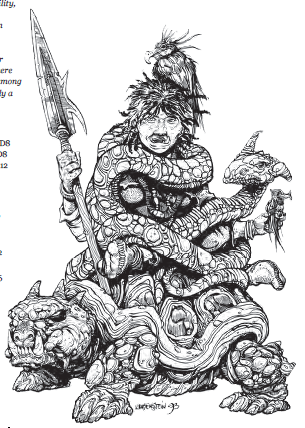
Beastmasters are really unusual. They can (as you'd expect) bond with and train animals, in addition to dominating them for short times. They get some wilderness-ish skills, too. In combat, they transform their hands into claws and rip their opponents apart. It looks like it requires more maintenance than most Disciplines, given all their potential beast buddies, but if you love 80's fantasy movies, this is a good pick.
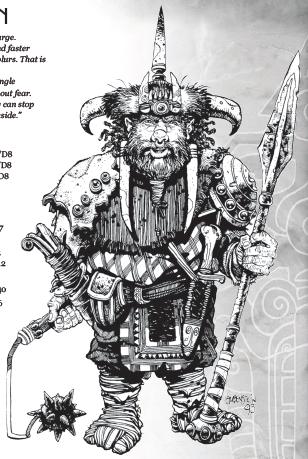
* Horse not included.
Cavalryman is its own Discipline, too. They get some of the animal stuff a Beastmaster does, can make magically-infused Charge attacks, and share health with their mounts. I am not sure what they do with their mounts while exploring a kaer - that's always been the difficulty with mounted characters - but around Third Circle it looks like they can summon a "Spirit Mount."
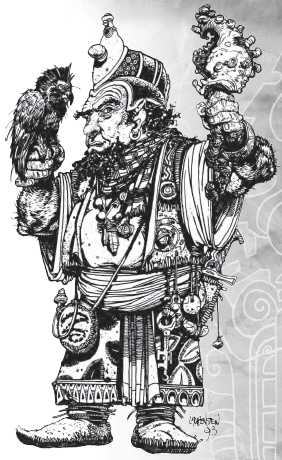
Elementalists are flashy spellcasters who (as you would expect) wield the power of the five (basic four + wood) elements against their foes. It's notable that basically every spellcaster in the core book is identical at 1st Circle; as in so many other games, their spells define them. This is partly because spellcasting is so Talent-intensive; you need your Spellcasting Talent, two Spell Matrices (which are an awesome idea), Read/Write Magic, and Thread Weaving. Add in your Karma Ritual, and that's six talents taken up right there. (Compare to an Archer, where you can feasibly just focus om Missile Weapons at first. And be boring, but...)
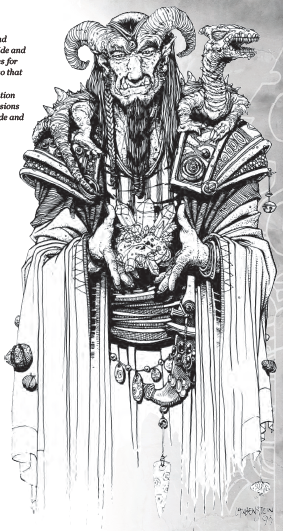
Illusionists are another caster. And ... well, just like it says on the tin. They get some trickier Talents as they advance in circles, but otherwise... See Elementalist. Regardless, this picture proves Trolls are even badasses out of their armor.
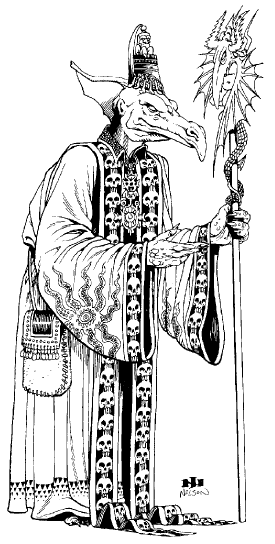
Nethermancers are our third spellcaster in a row. They deal with "spooky" stuff by and large - necromancy, spirits, and Horrors, for example. As such, they're pretty awesome. And they're pretty much spellcasters, again.
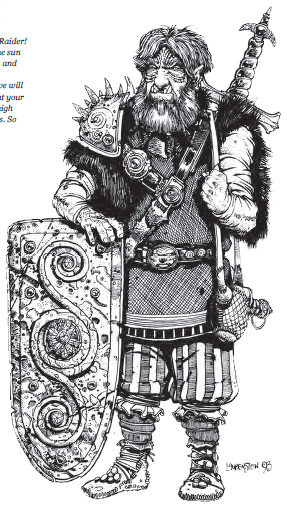
Sky Raider ... Ahhh, back to the bashy guys. They are straight-up Vikings, with such Talents as Battle Shout (yell loud, scare people) and Fireblood (spend a Recovery Test in combat) on their list. Clearly, this Discipline is made for Trolls. As far as fighting-types go, it's kind of a narrow specialty with its emphasis on Air Sailing. If you want a barbarian-type without the air sailing...
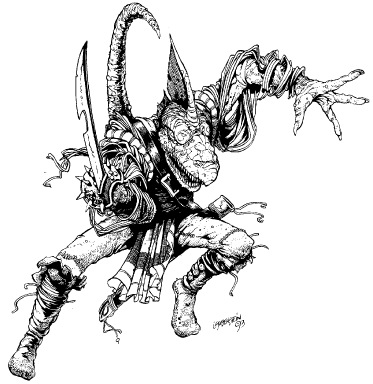
Swordmaster - Zorro, pretty much. Maybe Inigo Montoya. They are clever duelists who use their wits as much as their blades. (Taunt - one of their main Talents - is excessively broken in ED 1e.) They pick up various parrying and maneuvering tricks, and it looks like Earthdawn finally got the archetype right, as opposed to AD&D at the time. Basically made for T'skrang as much as Sky Raiders are made for Trolls.
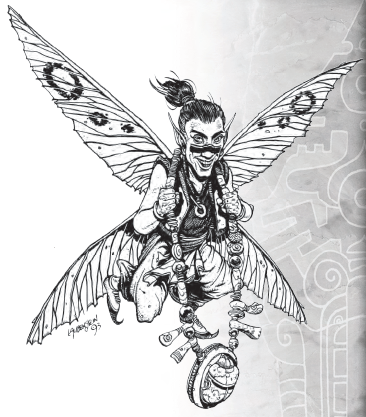
Thief - No Rogue here. They have a pretty darn big list of Talents to pick from, and it's all the Thiefy stuff you'd expect - lock picking, moving silently, picking pockets, and backstabbing. Weirdly, they look to use melee weapons and get screwed out of both Missile and Throwing weapons until they hit a high Circle.
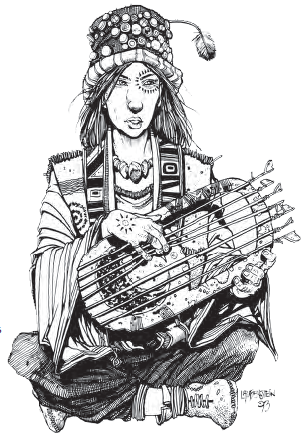
Troubadour - BARDS. Only they look ... more useless? I dunno, folks - the utility of a lot of these Talents is kind of questionable and/or situational. Yeah, it's awesome to be able to disguise yourself or charm a room, but compared to doing fighty stuff it's pretty corner-case. I dunno, it may be a playstyle issue, and they could get some incredible stuff down the line.
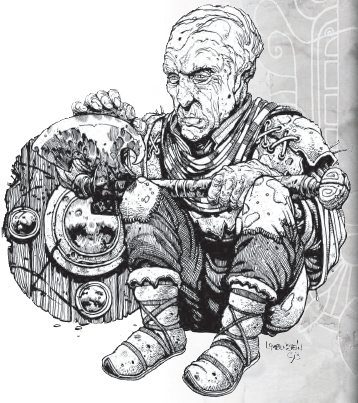
Warriors aren't as bashy as you might expect - though, yes, they are good at it. Their Talents are a cool mix of swordwork, acrobatics, and even some elemental channeling - like air dance which lets them move around like an air hockey puck and woodskin which lets them build up some serious natural defenses.
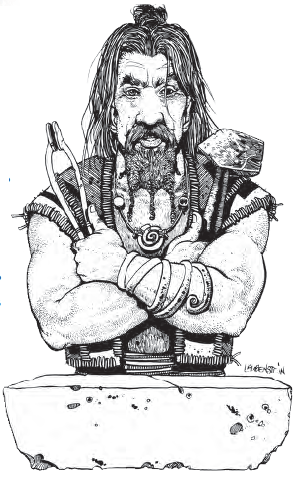
Weaponsmiths are a new (and rather unique) archetype for Earthdawn, and as much a "Leader" role - in the party buffer sense - as you'll find. They aren't great fighters, but they look solid at the support department. Their signature ability - Forge Blade - is actually insane, if they have enough time to use it. A party with a Weaponsmith looks to be incredibly deadlier than a party without one.
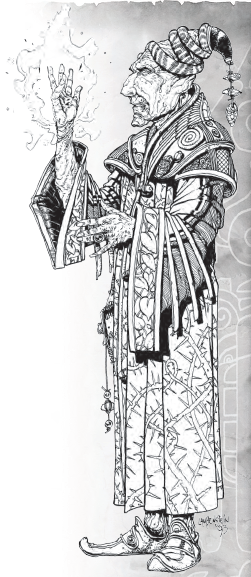
Finally, Wizards are the bookish spellcasters. Their spells look to deal with pure force, psychic energies, and the workings of magic (and magical energy) itself. Their Talents are as expected at first circle; later on they learn flavorful things like quickly memorizing books for later recall.
...and that's it for the Disciplines.
Okay, now there's a few weird bits here and there. Like I mentioned, Disciplines are straitjackets. For example. Let's say you're an Archer, but you want to be able to swing melee weapons capably. Well, tough shit. You're not learning that until Fourth Circle, and at that point it's competing with the vital Thread Weaving for your attention. Human Versatility? Forget it; Versatility can't let you snag a Talent your own Discipline gives you later. Skills are gimped so horribly they're not really an option either. So basically you're hosed, and two Adepts of the same Discipline will likely be built fairly similarly apart from a few trappings.
Earthdawn 3e does a number of things better. For one, it gives you a good list of Talent Options you can take at various stages. For another, it gives you abundant free ranks in Skills, which can work in a pinch. Overall, though the core of each Discipline is set, in 3e you will probably see a lot of variation. For example, an "Archer" specializing in Thrown Weapons is not only possible, but completely badass. (And they can do okay with melee weapons if they want from the start, too.) 3e also incorporated two other "core" disciplines, the Air Sailor and the Scout, into the main rules.
What's either cool or baffling is that Disciplines are mostly just a bundle of linked Talents with a few leveled abilities here and there like "+1 to Physical Defense" or "Can spend Karma on damage rolls with swords." It's their Discipline Talents - and specifically the ability to spend Karma on them - which makes the difference (and screws Obsidimen and Trolls, but I already did that rant). Which makes it so baffling that you need to look at the Talent descriptions to see what's a Discipline Talent for which Discipline. You'd think asterisks or something would have been an obvious benefit...
So that's a quick side-trek down Discipline Lane. Next time I'll make my Troll, I promise. And a spellcaster, because it must be done.
Other Disciplines, per request
Original SA post
Part 5b: Other Disciplines, per request
This is going a bit afield of the core book, but the question was asked, and I thought I'd answer right away, before I forgot.
Most Disciplines in Earthdawn go up to Fifteenth Circle ... but only the first 8 are presented in the corebook for both 1st and 3rd Edition. (The "Classic" edition put everything in the same book, making it 500 pages on the player side and 500 pages on the GM side. Which ... ugh.) To get to 15th circle in 1e, you needed this book:
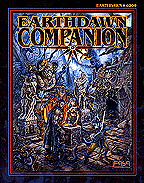
But please note - getting to 15th Circle is probably not normally going to happen. The amount of Legend Points needed is simply vast, and it looks to my untrained eye like the game's balance and math just get completely fucked - possibly before even 8th Circle. (If you ever played Earthdawn higher than this, let me know how it worked out... I am skeptical of anything past 6th or so.)
Anyway, the Companion had two new 1-15 Disciplines: The Air Sailor and the Scout. The former seems kind of niche to me, but the latter seems like something people would legitimately want - a stealthy character without the focus on theft. These two were completely "core" from here on out; later editions included them in the main book.
There were quite a lot of other Disciplines presented in supplements, and frankly, these were the sorts of neat ideas that separates Earthdawn from most other fantasy games. Mostly, they were in these books:
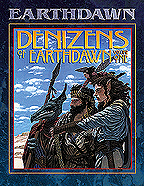
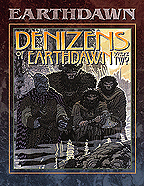
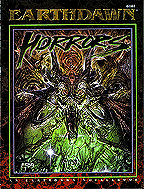
There were a few others introduced over time, but quite honestly I can't remember when and where. I want to say either on the (fairly young at the time) web, or in magazines.
So here we go...
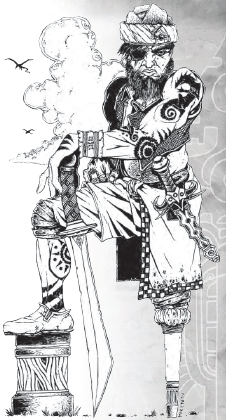
Air Sailors are basically Sky Raiders with a bit more focus on acrobatics and a bit less focus on "troll." It looks like they work perfectly well for anything from airship pirates to airship explorers. This is one of those weird ones - like the Cavalryman - that seems to dictate some directions for the group's adventures... I mean, without an airship, it just seems a bit out of its element. They should be okay; there's some Swordsman mixed in, but...
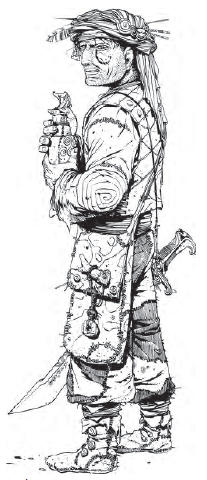
Scouts scout. That's their purpose - stealthy movement and exploration, with some good woodsy sorts of Talents like Tracking, Climbing, and stealing animals' senses. So if Air Sailor was "Sky Raider minus Troll" this is "Thief minus stealing shit"
As I mentioned, both of the above are 1-15 Disciplines. The remaining Disciplines are mostly race-restricted and limited to 8th, 10th, or 12th Circles. At least, in 1st Edition they are. In 3rd Edition, they have full 1-15 progressions. If you get to max Circle, you can always pick up a second discipline in an intricate and difficult-looking set of fiddly rules.
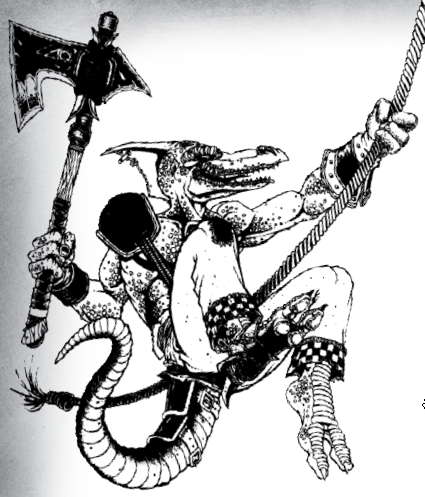
Boatmen are restricted to T'skrang. These are Air Sailors, minus the Air part. They are pirates and riverboat captains piloting boats down the Serpent River - a huge waterway that goes past nearly every major landmark in Barsaive. They are limited to 8th Circle.
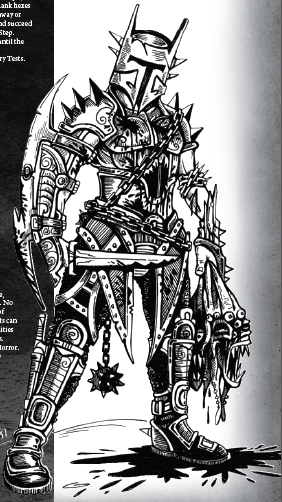
Horror Stalkers are straight-up nuts. Okay, bit of background - a Horror's most feared power is often its Horror Mark. This lets them use their scary powers on you at a distance, and possibly use them against the people around you, whenever they want. Horror Stalkers seek out these Horror Marks on purpose and use them to track Horrors back to their lairs so they can kill them. So think of it like a honeypot for malware - they gain the Marks, sequester them, and use them to track the Horror. This Discipline goes to Tenth Circle, but I think the survival rate is a lot lower than that. Still - awesome idea.
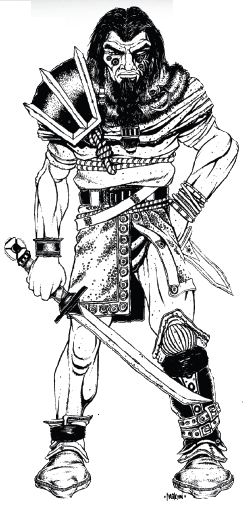
Journeymen are a Human-only Discipline, limited to 9th Circle, but ... gah. Wow. Okay. If you are not happy with any other Discipline, this one more or lets you invent your own. From scratch. But it advances slowly and I'm not sure if it's allowed to spend Karma on any Talents it's not required to? I'll be frank, it looks insane and half-baked. They are still insane in 3rd Edition.
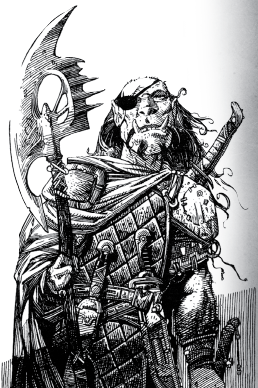
Liberators are made of awesome. It's Ork-only, and dedicated to freeing slaves. (With Thera ever-present, there's plenty of them to go around.) It goes to 10th Circle. Among their tricks are the ability to summon up mental armor and weapons , break shackles, and inspire rebellion ... so they can get enslaved themselves, incite an uprising, kill the slavers, and free everyone. It's kind of hard seeing how one would fit into a normal party, but who gives a crap? This is an awesome idea.
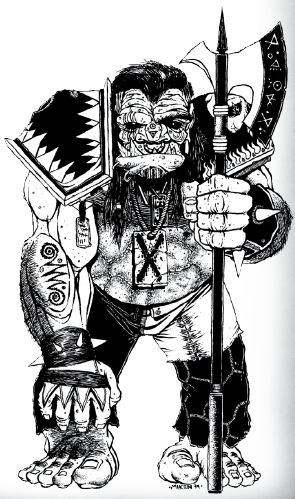
Outcast Warriors continue with the awesomeness of Trolls. Basically, they have had their horns cut off after being thrown out of their tribe over a disagreement on honor. Then they proceed to kick ass . It's mechanically kind of a combination between Warrior and Sky Raider, but sadly limited to Eighth Circle.
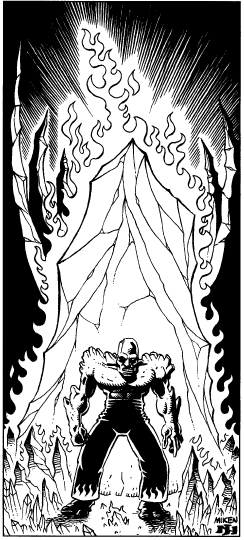
Purifiers are about my favorite. What would you get if you took a D&D monk, made them less shitty and made out of rock, and then had them work for Greenpeace? That's basically a Purifier - eco-terrorists who kill things that despoil the land, particularly Horrors. They fight unarmed and use a discipline called Body Control to make their fists awesome. Like this:
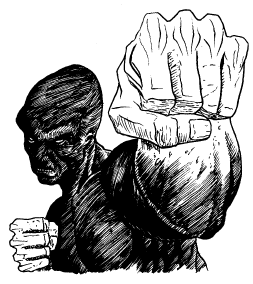
Anyway...
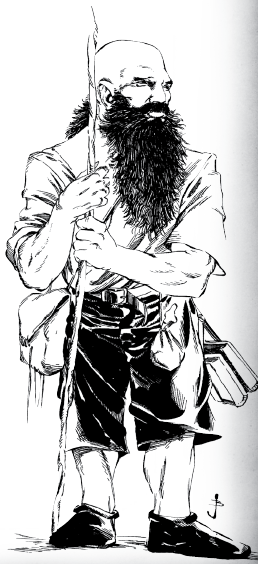
Oh, Earthdawn. Why must you continue to make Dwar
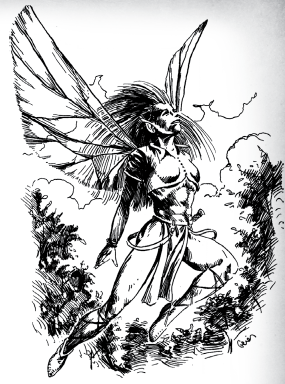
The Winddancer is the first Windling-only Discipline. They seem kind of non-adventurey, honestly - the Earthdawn equivalent of an NPC class. They have no offensive capabilities whatsoever at first, but can dodge pretty well. They're a very serious Discipline that puts messages into their flight and blah. Oh, but they can talk to bugs.
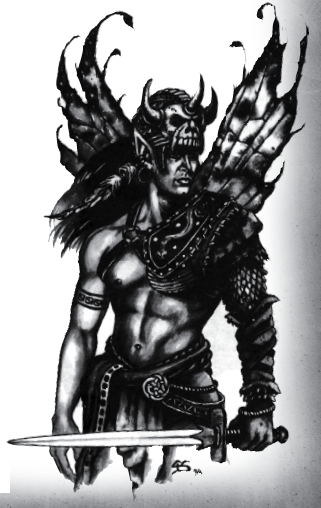
Windmasters make more sense. They're the melee warriors among the Windlings, so they can poke people to death with dagger-sized Greatswords. (And honestly, given their awesome Karma die, they are pretty good at it!) This fills a niche... More or less, a lot of the stuff Warriors learn is a little less useful if you can fly. Dive Attack is their big thing, and it's ... scary, for an 18" tall dude.
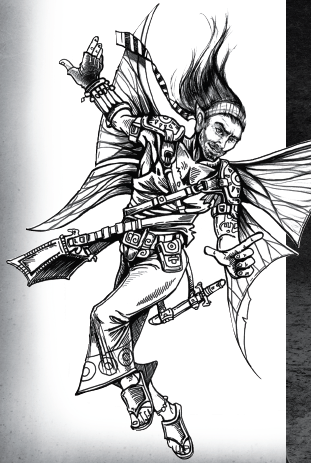
Windscouts are Scouts. With wings. They can track flying creatures, though, which is honestly pretty cool.
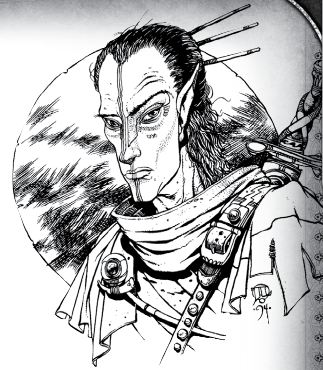
Woodsmen are, not to put too fine a point on it, elven rangers. They are basically Scout + Elf. Otherwise, there's not much more to say about them... They are a good alternative to a Scout if you're an elf because you can shoot stuff with bows earlier.
And that's it for the other disciplines. The 3rd Edition book has a few more - the Shaman, who I vaguely remember not understanding. And some weird ones like Messengers and Songsmiths. I dunno.
So yeah, there's more lameness than I remember. But the Liberator, Purifier, Outcast Warrior, and Windmaster more than make up for it, IMO.
Next time: We will finally make a goddamn character or two! Or three!
Making a Non-Caster
Original SA post
Part 6a: Making A Non-Caster
Before I get into the weeds with casters or non-standard Disciplines like the Windmaster (which was actually unplayable until some errata was released), we're going to do a few quick Core-only characters. First up? A troll!
Large Lars, the Troll Archer
Okay. I love the idea of a huge-ass archer firing a gigantic bow, and I love Trolls, so we're doing this. I'm going to go down the steps in order, much like I did in my Powers & Perils F&F . But hopefully with less
 and more
and more

I'll note - I have a ton of notes written into my duct-tape-spined Earthdawn 1e book. I think most of it is errata, but some might be houserules. Apologies in advance.
1. Choose a Discipline
Done. Badass Archer.
2. Choose a Race.
Done. GODDAMN TROLL.
3. Generate Attributes.
Now this is interesting. This was, when I ran into it, the first table-based point-buy I'd ever seen for attributes. We'd done "point-buy" for AD&D 2e, but this table scaled upwards as the stats got higher, much as in the later 3e and 4e D&D.
The point buy system here, however, is disappointingly jacakassed and you can see that it was a pretty new concept. Instead of low points, with the 0 mark centered around 10 or so, you get 66 goddamn points with 5 being the 0 mark.
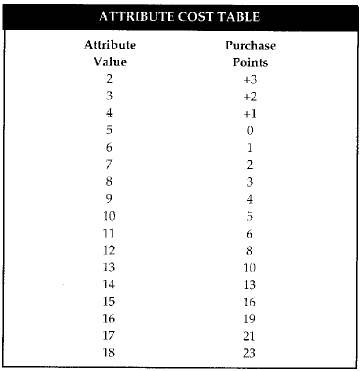
I look at the Racial "Abilities" table, and as a Troll, I need a minimum of 11 in Strength and Toughness. It turns out this is the minimum I need to buy , so that's fine. I was going to do that anyway. Archers need Perception and Dexterity; I'm going to add Strength into the mix for my javelin-shooting bow - because doing massive damage at range is awesome.
My stats are bought, and look something like this...
pre:
Buy Final Step Dexterity 16 16 7 (1d12) Strength 15 19 8 (2d6) Toughness 12 14 6 (1d10) Perception 15 14 6 (1d10) Willpower 10 11 5 (1d8) Charisma 7 7 4 (1d6)
(Rolling 4d6 Keep 3 is provided as an option too. But the core book is pretty straight up about how terrible an idea it is. You get unbalanced or shitty characters, and you have to rely on chance for an interesting character. So, kudos to FASA for presenting point buy as the suggested option.
4. Determine Characteristics
Oh good. Now I get to find out what other stuff my stats mean. Besides Steps, that is.
Dexterity contributes to my Physical Defense and Speed . 16 gives me a Physical Defense of 9; more or less, this is the number someone needs to roll to hit me. My Speed as a Troll is based on my straight-up Dexterity score (unmodified) and is 38 yards in Combat and 75 yards Full. (Movement rates in Earthdawn are straight-up jacked. Also keep in mind they suggest 2-yard hexes for the map.)
Strength gives me my Carry/Lift . I can carry 270 lbs of gear without breaking a sweat. 540 lbs will stop me, though.
Toughness gives me my all-important Death Rating, Unconsciousness Rating, Wound Threshold and Recovery Tests .
My Death Rating is how much damage I can take before I die; it can improve later with the Durability Talent. My Death Rating is 36. As you might gather, my Unconsciousness Rating is how much damage I can take before getting knocked out. It's 28 for me, and will come into play a lot more than my Death Rating.
My Wound Threshold is 10. I'll get to this later, but more or less if I take at least this much damage in a single hit, I get a Wound (which slows down healing) and might get Knocked Down.
Finally, I get 3 Recovery Tests per day. Think of them kind of like 4e's Healing Surges in that they are both a capacity for self-healing and (usually) a limit on what meager magical healing exists. You also use them for some Talents like Wood Skin.
We still have 3 more stats to go, folks, but Toughness was the big one.
My Perception mostly gives me my Spell Defense . With a 14, I have an 8. That's the number someone needs to roll to hit me with a spell.
My Willpower is used for Mystic Armor . This is inherent, unlike physical armor (bony plates be damned!). I get 1 point. Living or once-living armor can improve this.
Charisma gives me my Social Defense. It's not as silly as it sounds; some Talents like Battle Shout and Taunt will attack this directly, and those are seriously bad scoobies. It's a pathetic 5, meaning I'm hosed if someone does that to me.
Finally, on account of being a troll with good stat modifiers, I'm Karmically Challenged. My Karma Die is a measly d4. It costs me 10 Legend Points per. I start with 6, and can have a maximum of 20 at any one time.
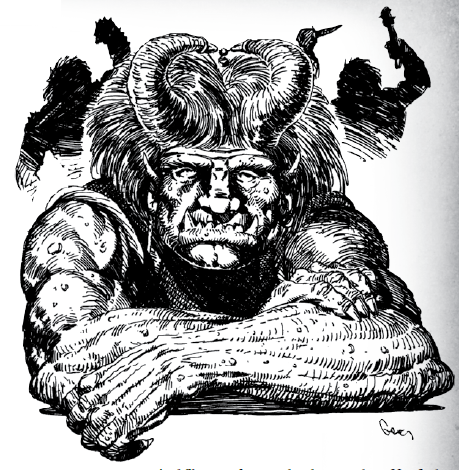
Lars is not impressed with his Karma
5. Record Racial Abilities
I have Heat Sight. Classic D&D Infravision. I can switch it on or off. It's more a "predator sight" than "darkvision," too - which I kind of love.
6. Assign Talent Ranks
I get to assign 8 Ranks among my Talents, 1-for-1. Archers start with the following Talents...
Avoid Blow - Very useful. For 1 Strain (like taking a point of damage), I can roll my Avoid Blow dice against an attacker's attack. If I fail, they still hit and I still take the Strain, too. If I succeed, the Strain is all I take. I'll put 2 Ranks into this for now, but might come back to it later. My Dex Step of 7 + my Rank of 1 means I have a final Step of 9 and roll d8+d6. My Physical Defense is 9, so it's risky. But... it'll improve.
Direction Arrow - Kind of weird and situational? But definitely a cool effect. More or less, I can locate a person or an object by shooting an arrow up into the air. I am unclear if I really need arrows for this? Anyway, it's neat and I'll put 1 Rank into it so I can improve it later. Step 7 total, or 1d12. It's a Discipline Talent for me, which means I can spend my massive 1d4 Karma Die on it if I need to.
Karma Ritual - I can do this once per day and buy a number of Karma points equal to my Ritual Rank. It's one of those things I will want to spend Legend Points on, but for now, 1 is fine.
Missile Weapons - Does what you'd expect. I shoot stuff at other stuff, making it hurt. It is a Discipline Talent for me. I put 3 Ranks into it, giving me a total Step of 10 or d10+d6.
Mystic Aim - It's basically a magical laser-sight for my weapon. I waste a round using it, going against their Spell Defense and costing 1 Strain. Then until I fire or the target moves out of sight, I get +Rank to my Attack and Defense. Uhmmm... Sounds like kind of a poor deal compared to just shooting them again? I skip it.
True Shot - When you really, really, really need to hit, you can use this to drain all your Karma. Basically, you make an attack and have to spend Karma on it. After that, you must spend Karma up to your True Shot rank until you hit. At 1 Rank, it doesn't do much for me yet, but I figure I'll take it so I don't need to learn it later, like with Direction Arrow.
So that's all 8 ranks. 1 on Karma Ritual, Direction Arrow, and True Shot. 2 on Avoid Blow, and 3 on Missile Weapons. I am happy with this. I have no spells, so I'm on to ...
7. Assign Skill Ranks
This is kind of miscellaneous background stuff, by and large.
I can speak Dwarven and Troll. I can also read and write Dwarven, on account of my ancestors being stuck in a Kaer where the Book of Tomorrow was the only good reading material.
I have two whole ranks to spend on Knowledge Skills. I am going to choose Troll Lore and Legends & Heroes. Both at 1 Rank, which puts me at Step 7 or 1d12. So I know a lot of stuff about trolls, heroes, and troll heroes.
I also get an Artisan Skill at 1 Rank and this is a puzzling one, kinda? Although it has no basis in game mechanics, apparently the Horror-Corrupted can't manage the proper focus or state of mind to create things. So, everyone learned an art or craft to prove they're not Horror-tainted. (It's important to note, near as I can tell, that this isn't referenced anywhere else and it might be an urban legend.) Anyway, I will take Rune Carving so I can make my missile weapons and armor look even more badass. I have that at 1 Rank, too.
Skills in Earthdawn 1e are for flavor, basically. There's entire lists of Skills later on - and a whole lot of Talents than can be learned as Skills - but by and large, those aren't for PCs.
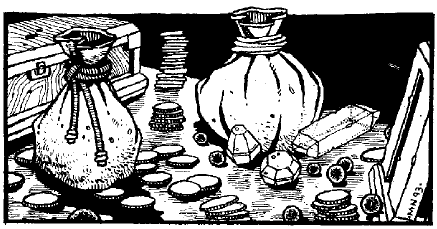
8. Buy Stuff
Yay! Shopping!
I need armor, a missile weapon, maybe ammo, and whatever else.
Earthdawn has a pretty neat "Weapon Size" system which is based on your race. Most characters can wield up to Size 3 weapons 1-handed and Size 6 weapons 2-handed. Trolls and Obsidimen go 4 one-handed / 6 two-handed, so they can use slightly bigger weapons in one hand; the book presents several options. Windlings can only use 1 one-handed / 2 two-handed, which is more or less Dagger- and Shortsword-size.
Armor is likewise different for different races. As a troll, my armor costs 10% more and weighs 25% more. I don't care about the latter; frankly, I'm getting nowhere near 270 lbs here. Note: Even though my armor is heavier, it's no more protective.
I buy Padded Leather for a cool 22 coins (it would be 20 for a human). Heavier, more protective armor in Earthdawn has Initiative Penalties as its balancing factor; as an Archer, I feel it's important to go first, so I cross those off right away. I now have a Physical Armor Rating of 4. (I was tempted to get Hide for 50, but it was a bit out of my budget. It would have given me Physical 5 and +1 to the Mystic armor I picked up with my Willpower score for a total of 2. And -1 to Initiative, which I found unacceptable at the moment.)
So... Weapons! Right before I buy my bow, I notice a "Troll Sling" on the list. It's a bit shorter-range than a bow, but it's basically a big ol' staff-sling at Size 4. Which means I can wield it one-handed! Ammo's also apparently free, being pretty much baseball-sized stones. That sounds like a pretty good deal, so I snag it until I can afford an Elven Warbow (or ... hmmm, crossbow?) down the line. It's only 15 silver. I will deal an intimidating Step 12 damage with it, or 2d10.
So now I circle back to shields, since I have a hand free. And ... ah well, a Buckler's the only one without an initiative penalty. That's 5 silver coins, and it gives me +1 to Armor. In theory I could use a bigger shield, but my GM (me) might give me problems about loading the thing one-handed.
I should get a Melee Weapon, so I pick up a Troll Sword for a painful 50. I can use this one-handed, too. I am not great at it (rolling 1d12 for Melee Weapons) but it hits harder than my Sling, dealing Step 14 (sigh... d20+d4) damage.
That brings me to 92 Silver, I think. For 15 more, I buy an "Adventuring Kit" which has all my bare necessities. I keep the rest.
9. Flesh out your character
Earthdawn has an excessively dumb way of dealing with fleshing out your character. There's a massive list of personality traits. In theory, I pick one (or more) Surface traits and one (or more) Hidden traits. Because, you see, there's the ME you see and the ME I really am.
This gives the GM guidelines to reward you with Legend Points for roleplaying. I think the "traits" bit is fine but the "hidden" half is just way too much for a player to think about - or a GM to remember.
Oh, and then I get to fill in the rest of the blanks. Age (21), Height (8'7"), Weight (517 lbs), Hair (Patchy, green, bony), Eyes (COLD AND DEAD), Skin (vaguely greenish, tattooed in blue).
...and that's basically Lars.
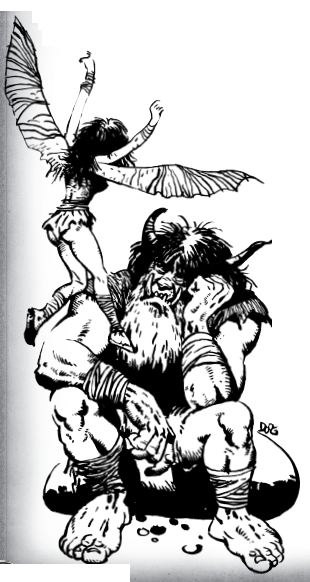
Lars the Large and his Windling cohort, Terribella
10. Play the game
 I can't.
I can't.
That's it for Lars the Large. I'll be completely frank - I really like how simple it was to put him together, and I'm extremely satisfied with the result. This is a character I think I'd have fun playing for a long time.
Next Post: Terribella, the Windling Windmaster. And Ulgrin the Acerbic, Dwarf (maybe Ork) Warrior. Both a bit briefer because you know the process by now. Then a whole 'nother post for Malbazar the Magnificent, Human Wizard. And after that, I'll make one of these four in Earthdawn 3e for comparison purposes.
Two more quick non-casters to round out the party
Original SA post
Part 6b: Two more quick non-casters to round out the party
As promised, I'll be making a Windmaster. I'll also be making a Dwarf Warrior to try and make a non-shitty dwarf in Earthdawn. (He will also have a strange speech impediment where he mispronounces "dwarfs" as "dwarves" because really, FASA...)
Ulgrin the Acerbic, Dwarf Warrior
Let's go with the Dwarf Warrior first.

What's more, we're going to experiment, boot up DOSBox , grab the old Earthdawn CD, and run EDGE - more or less the 4e Character Builder, only for Earthdawn, DOS-based, and like 15 years earlier.
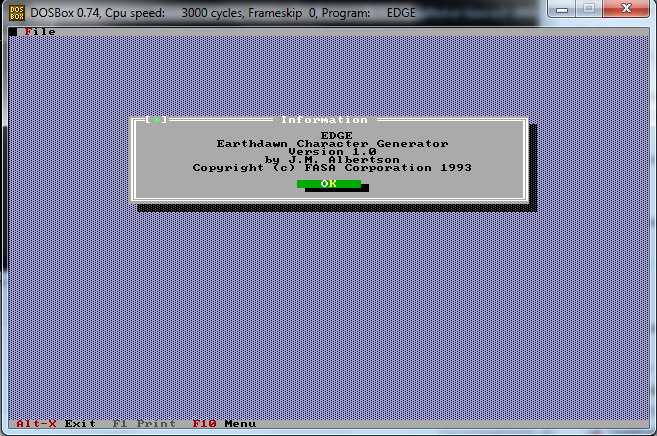
Graphics have come a long way
Okay. So considering the time and the limitations... EDGE is a pretty outstanding piece of software. It has a few quirks, and DOSBox is not 100% awesome at dealing with them, but as long as I use the keyboard (the mouse only goes halfway down...) it's pretty great.
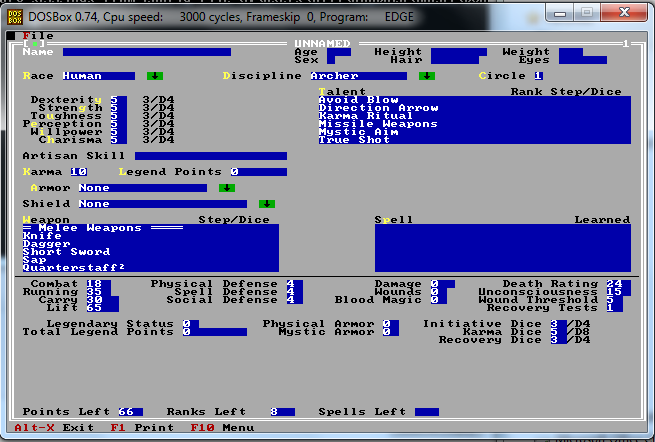
I mean, it has most of the necessary bits right there. Annoyingly, there's no indication of my stat modifiers, so I'm basically operating blind on stats. And there's no equipment purchasing interface, so to speak, so I need to keep manual track of money. But it still keeps everything put together quite nicely.
So let's look at Warriors...

Warriors excel at battle, as you might expect, but they're no dumb brutes. They utilize magic and acrobatics to great effect, and can perceive the ebb and flow of a combat very effectively. At 1st Circle, they get the following Talent options...
Acrobatic Strike: It's not a Discipline Talent for me, but it does Require Karma...
-------
Okay. Quick sidebar. Some Talents Require Karma, and it's listed as such in the Talent description.
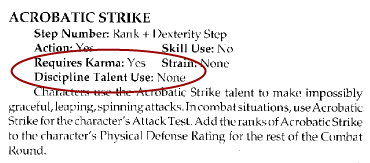
This is confusing and counter-intuitive as all fuck, so bear with me. If a Talent is not a Discipline Talent, but it requires Karma, you must spend a Karma point to use the Talent. You get the benefit of the Karma point as normal.
If a Talent is a Discipline Talent and Requires Karma, like this one for Beastmasters...
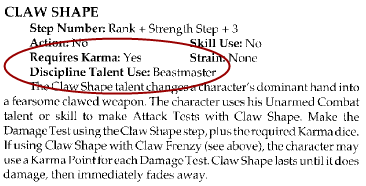
Claw Shape is fucking awesome, for the record.
... then you do not have to spend Karma on it, but you can if you want to . So when it says "Requires Karma" it really doesn't require Karma if it's a Discipline Talent for you. Why? Earthdawn. No idea.
-------
Okay. Sidebar done. Back to Acrobatic Strike. Anyway, I must spend Karma on it, which is usually okay with me, because that's how you hit stuff when it counts. After using it, I get to dodge blows better for the rest of the round. Helpful to have, but mostly neat. It seems worthless if I don't invest in it, so I put 2 Ranks in it.
Air Dance: This is the Warrior's coolest trick, IMO, and well worth buffing up to ridiculous levels. You get to basically float an inch above the ground in combat like an air hockey puck. It substitutes for your Initiative check, and if you double your opponent's Initiative, you get to make a second attack against them that round. Extra attacks are rare this early, so this is just great. 1 strain, but I'm a Warrior so don't care much. I put 2 Ranks in this.
Karma Ritual: The details of the ritual differ, but the effect is the same. I'll be boosting it down the road, for sure. 1 rank.
Melee Weapons: Me fight good. Discipline talent, naturally. 2 Ranks.
Unarmed Combat: Another Discipline Talent, but not really in character for this guy. I skip it.
Wood Skin: A Discipline Talent, and it's pretty awesome. More or less, it lets me proactively use a boosted Recovery Test before taking damage. I can also spend Karma on it, so that's cool, too. My skin turns all hard and wooden, and I get to increase my Death and Unconsciousness ratings by the test result. I have 1 rank left, so I go with it.
Gear-wise, I decide to get protective stuff and a good weapon. I buy Hide Armor, a Footman's Shield, and a Broadsword. Afterwards, I have a formidable 8 in Physical Armor, 2 Mystic Armor, and my Initiative is reduced to a d8. The book doesn't mention (yet) if I suffer armor penalties to my Air Dance. If I don't,

Since I don't know how to (or if it's even possible to) route a printer through DOSBox, here's my finished character. Ulgrin is a tough little bastard.
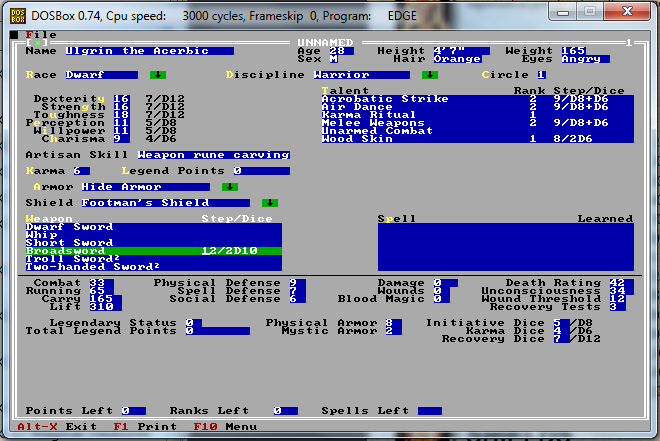
(I remember that the character sheet printouts from EDGE were actually pretty badass. You actually got the text for your Talents spelled out in full , if you wanted it. Again, a pretty serious precursor to the 4e Character Builder.)
Terribella, Windling Windmaster
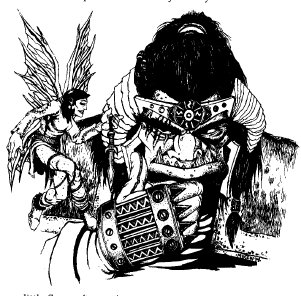
The inspiration
Making a Windling is a bit of a different process than making most other characters, and honestly it's a good thing that Denizens of Earthdawn: Volume I came out with a few Disciplines dedicated to them. I mean, don't get me wrong - Windlings are arguably the best spellcasters and Troubadours in the game, and are no slouches at stuff like Thievery and Archery. And with their Karma die, even Disciplines like Swordmaster work ... pretty well.
Windmasters are very similar to Warriors in a lot of ways, only more Windling-ish. I'm going to powergame the hell out of this, because when you're making an 18" tall primary-melee combatant, you pretty much have to. Their Strength and Toughness are nearly crippling ... or are they?

I can't use EDGE for this one; that program supports core-only. It's a shame, but it's not like making an Earthdawn character is particularly hard.
The only oddball bit here is that I can buy no more than an 11 in Strength. Afterwards, I'll be left with a 7 at best, the minimum for Step 4. My final stats are as follows...
pre:
Stat Step Dexterity 19 8 (2d6) Strength 7 4 (1d6) Toughness 12 5 (1d8) Perception 11 5 (1d8) Willpower 11 5 (1d8) Charisma 15 6 (1d10)
Movement Rate is based off Dex+2 for Flying and Dex-8 for Land. That's 65 Combat/110 Full for flight and 27 Combat/54 Full for land.
I can also carry a hilarious 40 lbs without slowing down. Remember - I'm 18" tall.
For Talents, I have a slightly different mix than a Warrior. And in case you think "poor editing" is a new phenomenon in RPGs, I need to point out that on publication, Windmasters had exactly ZERO Discipline Talents on which they could spend Karma. They forgot that part. FASA publised errata both online and in the Earthdawn magazine, The Earthdawn Journal.
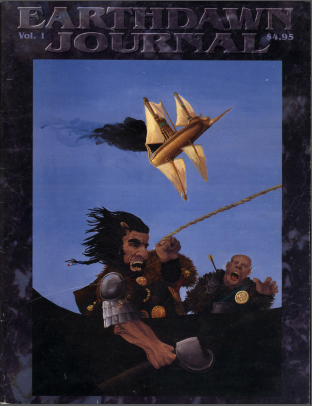
Forget what I said about Trolls always being awesome.
For my Talent selections, I end up with...
Karma Ritual : 1 rank. Will boost, of course. I plan to eat Karma like popcorn because it's the only way to play a broken-ass Windling.
Avoid Blow : 2 Ranks; I have a Step 10 or d10+d6. While that is overwhelming with my Physical Defense of 12, it's a Discipline Talent so I can roll 2d10+1d6 when it counts. That's pretty massive, and I'm going to annoy my GM.
Dive Attack : 2 Ranks. It's a new talent, and simply wonderful . Although it requires Karma, it's one of my Discipline Talents, so it really doesn't, for me. (see above) It's 1 strain, but I can eat that. Basically, I make this instead of a normal Melee Weapons test, but I need at least 120' of clear flight space and get at least 20' up. If my attack hits, I get +4 to the Damage Test, which I'll need because my damage is pathetic. Keep in mind - my combat movement is 65 yards per round. I am totally unclear on what the rules are for withdrawing from melee... We'll find out in a few chapters, I expect.
Melee Weapons : 2 Ranks. It's a Discipline Talent; my base Step is 10 for d10+d6, but as with everything else, I can pretty well spam it at 2d10+d6.
Throwing Weapons : 1 Rank so far. While nice to have for a flying deathbomber, it's a backup plan instead of a primary one. Not a Discipline Talent. I have Step 9, or d8+d6.
I could have picked up Unarmed Combat but I really, really don't see the point for her.
So take a look up there. All the stuff I want to do? Discipline talent. And because I'm a windling with cheap, awesome Karma (as opposed to a troll with shitty, expensive karma) it's kind of like having 6 extra ranks on every important roll I ever make. This is why I've been telling you Earthdawn 1e Karma is excessively broken. She could have been a spellcaster and not had to suffer for her shitty-ass Strength.
Artisan Skill? Um. Feather-weaving? Is that a thing? It is now. Knowledge skills? No idea; I'm a flying death-pixie. 2 Ranks in Windling Lore.
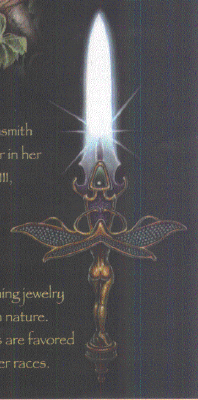
For weapons, I grab a "Windling Greatsword," also known as a shortsword. It's Size 2, so it's 2-handed for me. Its Damage Step is 4, so combined with my Strength Step of 4, I deal an astounding ... Step 8, or 2d6 damage.

Yeah, that's disappointing. Keep in mind, though, when I Dive, that bumps up to Step 12, or 2d10. And both my attack skills and my karma are excessive; remember that in Earthdawn, if you get an Excellent success against your enemy, you bypass all their armor. This should happen for me with fair regularity.
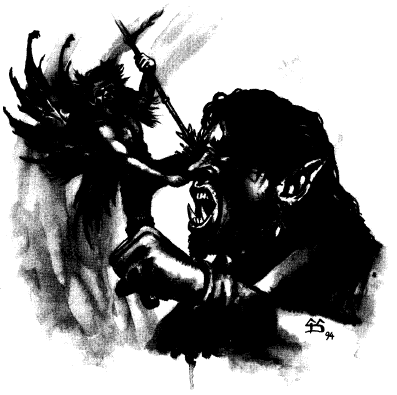
"Armor-Defeating Hit" means "I poke you in the fucking eye." Also, this makes me understand how a Windling with a sharp weapon could be scary.
Windling Armor costs 10% more despite being, basically, Barbie doll clothing. It weighs 1/5 normal, which is good. Strangely, despite how thin the armor is, it still protects me just as well. I find this a little weird, but I should have checked my expectations at the door when I was developing an 18"-tall greatsword-wielding pixie.
I settle on Hide, despite the Initiative penalties. My final Physical Armor is 5, Mystic Armor is 2, and Initiative is Step 7/1d12.
With my last money, I get a surprisingly expensive Windling Spear to use with my Throwing Weapons Talent. I deal a massive Step 6, or 1d10 damage with it.
After all this is done ... Terribella looks like a surprisingly capable character. I dunno; her damage-dealing ability kind of worries me, but I have a feeling she'll do just fine when I run a mock combat to put them through the paces.
Next up? Making a Spellcaster!
Malzabar the Magnificent
Original SA post
Part 6c: Malzabar the Magnificent
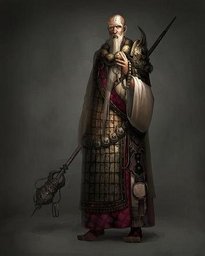
Alright! First off, big thanks to Everything Counts; I'm looking forward to it.

Moving on! The last character I'll be making is a Human Wizard. Why a Human? Well, what you need to know is there are three races who are awesome at spellcasting in Earthdawn.
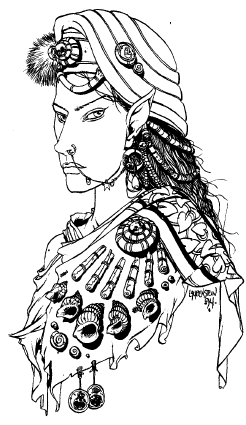
The first are Elves. They are the only race to get a bonus to Perception and Willpower - basically Strength and Dexterity for a normal combatant. They are nevertheless only a decent choice.
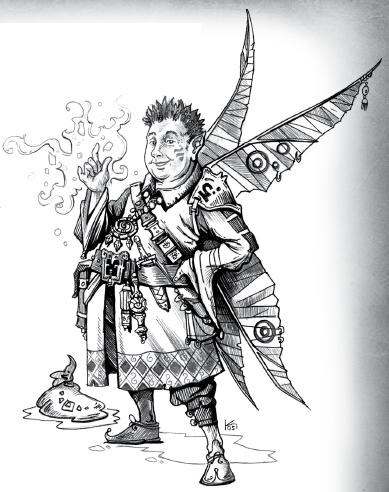
The second are Windlings. The reason why should be pretty evident... They get to bypass their bad Strength, get a Perception bonus, get a free +2 to their Physical Defense, can use Astral Sight without devoting resources to it, get a d10 Karma Die so their most important spells seldom fail, and can fucking fly to stay out of range of melee chumps. They are obvious choices, and it further shows that balancing a race only on their stats and Karma (and never looking at shit like flying and +2 to Physical Defense) is dumb. But. Even with all this, they are not necessarily the best spellcasting race.
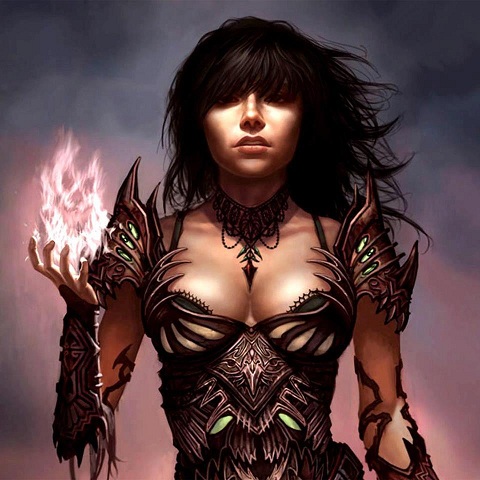
The best would be Humans. While they are boring stat-wise (no bonuses anywhere) really, it's not a big deal. And while they might not get a d10 Karma die, they get a d8 which is pretty damn good. And sure, they can't fly. All they have is their Versatility Talent ... but it's a goddamn whammy .
For starters, let's go over Versatility. In short, because Humans are so open-minded and curious, they can learn Talents from other Adepts and work them into their view of their Discipline. It's not that expensive, either - a Human can learn 1 other Talent per Rank in Versatility. Ordinarily, this is a good way to pick up a few good tricks - like learning Riposte for your Warrior.
For a spellcaster, it's downright amazing . The core of each Spellcasting class is largely common; each one gets a very similar mix of Talents, as I lamented a few posts ago. The main difference is that their Thread Weaving is different - there's Elementalism, Illusion, Nethermancy, and Wizardry. I think you can see where I'm going with this. All you need to do to be able to cast - for example - Nethermancy Spells if you already know the basics (spellcasting, matrices, read/write magic) is the Nethermancy Thread-Weaving talent.
So by spending a cheap 2 Ranks, Malzabar will be able to learn, select, and cast spells from two different lists. (It's also possible he could eventually learn all four - but that's a more extensive process, and far too expensive for a starting character.)
Don't get me wrong - there are other ways to pick up another Discipline's Thread Weaving, but none of them come quick, cheap, or early. And it's not excessively powerful per se - most spells are pretty balanced against one another. What it does, however, is give you access to greater breadth to shore up your own Discipline's blind spots and give you some better options.
Okay! So, Human it is. Malzabar will mostly be a Wizard because I like the idea of working directly with magic. He will also pick up Illusion because it's cool and fits his flashy style. Nethermancy is a bit too dark for his tastes, and Elementalism is a bit too direct.
So let's throw a few stats his way...
As a human, he has no stat modifiers. From experience making a few characters, I know that 16 seems to be the sweet-spot for important statistics. Because Perception and Willpower are basically Mental Dexterity and Mental Strength, I put 16's in them right off the bat. I also want a good Charisma, so I go with a 14. That leaves me without many points; I can afford 10 Dex, 7 Strength, and 12 Toughness. So here we go...
pre:
Dex 10 (Step 5/1d8, Physical Defense 6, Combat Move 25, Full Move 50) Str 7 (Step 4/1d6, Carry 40, Lift 85. Hilariously, Terribella is just as strong) Tou 12 (Step 5/1d8, Death Rating 34, Wound Threshold 9, Unconscious 26, 2 Recovery Tests per day) Per 16 (Step 7/1d12, Spell Defense 9) Wil 16 (Step 7/1d12, 2 Mystic Armor) Cha 14 (Step 6/1d10, Social Defense 8)
Talents for spellcasters are odd. With my plan to know some Illusion tricks, I buy up the following...
Karma Ritual: 1 Rank. Ah well.
Read/Write Language: I simply can't afford it. This would let me learn additional languages quickly and completely, but I'm already stretched for Talent Ranks.
Read/Write Magic: Because I want to be able to actually learn new spells at some point, I put 1 Rank here. Step 8/2d6; Discipline Talent.
Spellcasting: I would dearly love to put 2 Ranks here because this is basically my attack skill with spells, but I can't afford it. 1 Rank. Step 8/2d6; Discipline Talent.
Spell Matrix: 1 Rank, x2. I get two Spell Matrices. I'll get into this when I cover magic and spellcasting in more detail, but what this means is basically I can prepare 2 spells at once, and cast them at-will.
Wizardy: 1 Rank. This is my Wizardry Thread-Weaving Talent. It's super-important; I will need to roll it when casting a complex spell, when trying to attune myself to a magic item, or to quickly reattune my spell matrices. I'll get into this later. Step 8/2d6, Discipline Talent.
Versatility: This is that Human-only trick I mentioned before. 1 Rank.
Illusionism: ...and now I can learn, prepare, weave, and cast Illusion spells. Unlike Wizardry, this is not a Discipline Talent for me. In theory - in 1st edition at least - I can leave it at 1 Rank forever and cast as high a circle spells as I want. In practice, higher circle spells need threads woven on a regular basis, and I'd better keep increasing it.
Ordinarily, I'd just take my Artisan Feat (always Robe Embroidery for a caster) and my Knowledge skills (TBD), and then buy gear. Spellcasters get one more step - choosing spells.
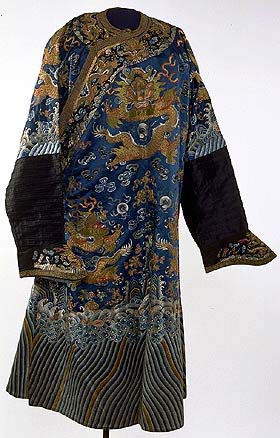
With Robe Embroidery, I, too, can be a New Age yogi.
I won't go over all the spells yet, but I get to pick 7 (my Perception step) and I'll go over those. Mostly I'm sticking with Wizard, but snagging a few Illusionist ones that look fun.
The first spell I pick is Mind Dagger, which is more or less the Wizard's staple as much as Magic Missile is in AD&D.
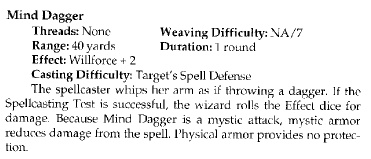
This is about the most basic spell possible. It has 0 threads, which means I can cast it every round - at-will. (So it's really a lot like a 4e At-Will spell.) The range is self-explanatory, the 1 round duration is basically "instantaneous". The Weaving difficulty just has a number after the slash; the 7 is the "reattuning difficulty" which I'll get to later.
I cast it against the target's Spell Defense much like a weapon goes against Physical Defense. The Effect is "Willforce + 2" ... But I only have Will power - so what's up?
Well, what's up is how Wizards get stupid-broken in Earthdawn 1e. Willforce is a 5th-Circle Talent, which is a Discipline Talent for all four casters. They improve it like any other Talent, and it is used for their spell effects. Since I don't have Willforce yet, it defaults to Willpower, so I'm just using that.
(But when I get Willforce ... watch out. It's insane.)
Anyway, Willforce +2 damage is Step 9, or d8+d6 damage. I'm not going to break any records with it, but it's all Mystic damage, which is generally resisted less than Physical. Since I can cast it every round, you can think of this as my "normal" attack.
For another spell example, here's one of my other choices...
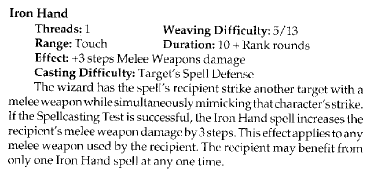
This spell has 1 thread, which means that in the first round, I make a Wizardry roll against a TN of 5. I can cast it in the following round. Note - I still need to cast against my target's Spell Defense because their True Pattern automatically resists magic unless they focus to allow me to do my work. (I think; I'll get to this later.) Otherwise, I am sure my dwarf and windling buddies will appreciate the extra damage.
To round out my spells, I pick Astral Sense (basically detect magic, only cooler), Dispel Magic (note: I can even dispel Talents), and Wall Walker from the Wizard side. From the Illusionist side, I pick Light (because you never know when you need it) and Disguise Metal for larcenous fun.
And that's pretty much Malzabar. Not really much harder than the other characters. I mean, I need to buy gear - but you've seen that part.
He looks like a fun character, too, unsurprisingly!
Next Time: The last character we're making, I promise. I'm going to make Lars the Large, Troll Archer Extraordinaire, in Earthdawn 3e to see how it's different. (And whether or not I like it better...)
What's Different in Earthdawn 3e?
Original SA post
Part 6d: What's different in Earthdawn 3rd edition?
So I've mentioned 3rd Edition on and off over the course of my ramblings, and I thought I'd take it for a spin for character creation. I can tell it's different, but I was curious to know how different. I remade all four characters in 3rd, but I'll only go over Lars the Large, Troll Archer Extraordinaire.
To help out (because I'm nothing if not lazy) I used an Earthdawn Character Editor I looked up on line. It's a bit clumsy, and I've stumbled upon a half-dozen bugs just in the course of converting all four characters over, but it's workable. (And it does a really good job with the character sheets.)
3rd Edition is similar enough to 1st that you would instantly recognize it. However, nearly everything has been either streamlined ... or made more complex, with the goal of increasing choice. The end result is that 3rd edition characters require more familiarity with the rules and take longer to build. (They are also significantly more capable - but we'll get there.)
The differences start in point-buy and the racial descriptions. You know how I mentioned there was some brief fluff about races and no stats for quite a few pages thereafter, scattered across 3 tables? Here's 3rd:
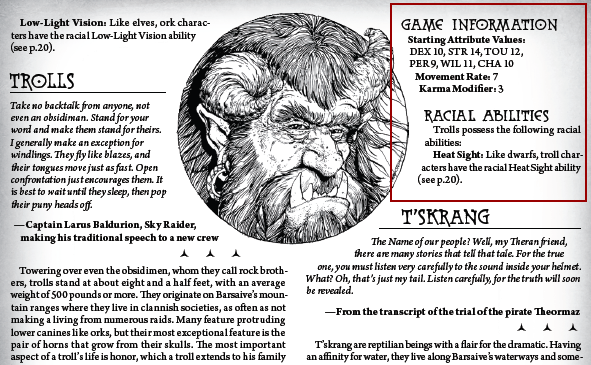
First off, there's a lot more fluff with actual information. Second, you get both "starting stats" instead of racial modifiers, and special abilities right on the page. (Also note: There's no "minimum strength/toughness.")
From those scores, you can buy increases (or get credit for decreases up to -2).
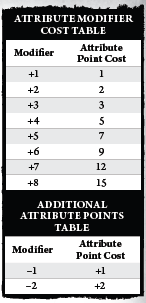
So the first thing I try to do is make Lars exactly like he was in 1e. To refresh your memories:
Dexterity 16, Strength 19, Toughness 14, Perception 14, Willpower 11, Charisma 7
I try to make that happen in 3rd edition, and notice two things off the bat:
(1) I can't lowball Charisma as much; 8 is as low as I can go.
(2) I have more points to go around! I'm left with points to spare, in fact. In the end, I'm able to boost my Toughness and Willpower, too!
(3) If you don't spend all your points, they go straight to maximum Karma, and ... well, we'll get to that really quickly.
pre:
Buy Step Dexterity 16 7 (1d12) Phys. Defense 9 Strength 19 8 (2d6) Carry 230 Toughness 15 6 (1d10) 3 recovery/day, 10 wound threshold, 30 Unc, 38 Death Perception 14 6 (1d10) Spell Defense 8 Willpower 11 5 (1d8) 1 mystic armor Charisma 8 4 (1d6) Social Defense 5
Karma has been massively overhauled, and IMO for the better. Each race has a Karma Modifier, so don't get me wrong - Obsidimen and Trolls still get hosed a bit. However, they're not screwed in 4 different ways - it's just the one.
Karma's the same for everyone - it costs 10 legend points, and it adds a d6. You still use it for the same things, but you have a lot more discipline talents you can spend it on. And your Maximum Karma is equal to your Karma Ritual Rank x your Karma Modifier. So Lars has 3 Karma, probably. It's not much - that's another difference - but I'm not as screwed as I could be!
Disciplines have been massively overhauled, too, and likewise for the better (albeit more complex). Here's part of the Archer...
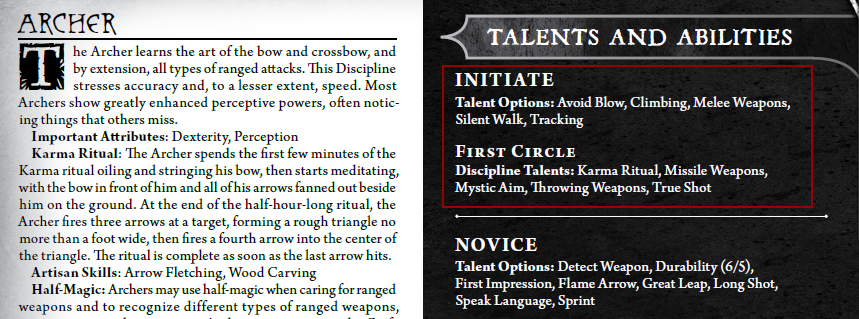
Kinda confusing, I know, but here's the long and the short of it...
My Discipline Talents are my core abilities. I can spend Karma on them, and (in 3rd edition default) I need to advance all of them to 2nd Rank before I can attain 2nd Circle. (This is far, far, cleaner than 1e; I haven't gotten to that part yet.)
Optional Talents aren't core, but they're commonly associated with my Discipline. Every Circle, I can learn up to one from either my own rank or any rank before mine. I can't spend Karma on them and they don't (by default) help me advance.
I still start with 8 free ranks. Last time, Lars got Avoid Blow 2, Missile Weapons 3, Direction Arrow 1, Karma Ritual 1, and True Shot 1. This time, I can't get both Direction Arrow and Avoid Blow ... and I'm locked into getting Mystic Aim before I advance much further.

Interestingly, I'm also locked into learning Throwing Weapons. Which is, honestly, a really interesting path I might go down when I can afford good throwing weapons. At the moment, since I plan on sticking with my Troll Sling, I will put 0 ranks there (with the knowledge I'll have to sink 300 legend points into it before long to get it up to Rank 2).
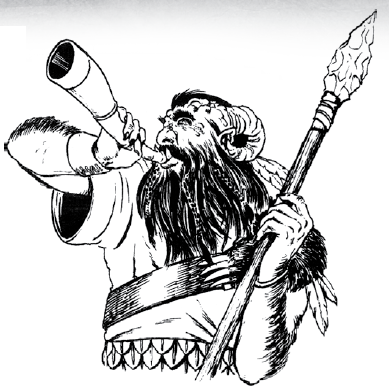
Gratuitous Troll shot
Now, I skipped ahead, because Earthdawn 1e is a hardass about learning new Talents - more or less, it's expensive and time consuming. Earthdawn 3e kinda keeps this, but with a good difference - as part of the ritual of advancing to a new Circle, I get a "placeholder" in my True Pattern - basically, I can "learn" the Talent at any time later by spending the Legend Points.
So this time around, I go with...
Missile Weapons, 3 Ranks (Step 10 total, which in Earthdawn 3e, is 2d8 instead of d10+d6.)
Avoid Blow, 2 Ranks (Step 9 total, d8+d6)
True Shot, 1 Rank (Step 8 total, 2d6)
Mystic Aim, 1 Rank (Step 7 total, 1d12)
Karma Ritual, 1 Rank
Throwing Weapons, 0 Ranks
Pretty good, really, and I'm still happy with it.
Next up are Skills, and this ... this is where Earthdawn 3e gets wacky.
There are skills in Earthdawn 1e, but pretty much only chumps use them. They are expensive to learn, take a long time to train up, and you basically don't start with any good ones. Sure, it was a way to pick up something outside your Discipline if you're desperate, but most of the time you're better off pretending they are even in the game.
Not so in 3e. In fact, you not only have the same Skills you did in 1e - 1 rank in Artisan (something), 1 rank in Read/Write Dwarf, 2 ranks in speak language, and 1 rank each in 2 Knowledge skills - but 8 more full ranks in whatever skill you want. I had to read this a few times to make sure I was seeing it right, because ... well, it seems maybe ... broken? It's really hard to evaluate this, coming into it cold, so I'll post what I picked up and we can look into it then.
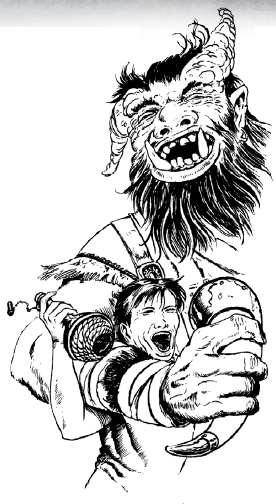
The troll is Lars. The little dude is the balance of the game. The headlock is a headlock.
So there's a massive list of Skills here and they're not in any convenient form like a table. Nope; it's a big list - think a big mess of AD&D spells or 4e D&D powers. For flavor, I start with...
Hunting: 2 Ranks. This lets me find food in the wilderness, as any Archer should.
Wilderness Survival: 2 Ranks. You can guess what this does.
Melee Weapons: 1 Rank. Yeah, you remember how I suck with melee weapons? I suck a little less now.

And here's where it gets iffy, to my untrained eye...
Second Shot: 3 Ranks.
Okay. Second Shot is an 8th Circle Discipline Talent for me. It lets me - as you might expect - take a second shot in a round, and it's something of a midpoint capstone ability for an Archer. The cost as a Talent is 1 Strain, and I could spend Karma on it... once I get it. The cost as a Skill is 2 Strain. I can't spend Karma on it. But I still get to take an extra shot any time I can afford the Strain.
I mean, maybe this isn't a big deal, getting an 8th-Circle Talent and 2 attacks per round as a newbie. Maybe 2 Strain is a huge deal. It seems kind of off to me, is what I'm saying, from my admittedly distant Earthdawn experiences. I should note also that Second Attack and Second Weapon are likewise available for Skill use - both of which do similar things, only for melee types.
As for me, I'd be tempted to house-rule these three skills away, but this is F&F so it's RAW all the way, baby!
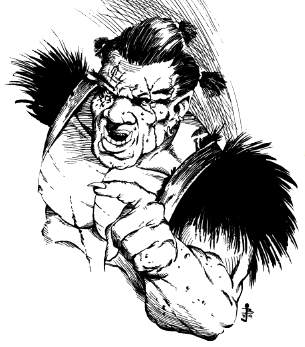
Only assholes houserule a game before playing it
(Also, I noticed some fun Skills in my perusal. I'll detail it in a post or two, but remember Ulgrin the Acerbic? My brute dwarf warrior? He just spent 3 skill ranks on Seduction.)
Equipment is basically the same - the main difference is you get a bunch of freebies like an Adventurer's Kit, and only start with 100 silver. No biggie; Lars gets the same weapons and armor as before.
Lars's Character Sheet
-=-=-=-
I updated the other three as well. Some stuff I noticed... (Links go to their character sheets) Note - there was a bug in the builder program, and I couldn't get their Armor to equip properly...
-
Ulgrin
was pretty close. His defensive stats got better, though. His Talents were really close, as well - at least as far as I can remember. He cheesed out with Second Attack in his skills, and also decided to learn the ancient art of Dwarf Seduction. He also picked up Shield Charge because it sounded useful.
-
Malzabar
, I changed around a bit. I decided to give him Elementalism instead, and his spells switched around. I wanted Air Armor, Earth Darts, and Heat Food (it's not nearly as lame as it sounds). He learned a few Social sorts of skills - Rhetoric, Taunt, and First Impression.
-
Terribella
had some of the biggest changes. For one thing, in ED3e, she doesn't actually have a Strength maximum. (She does start at a value of 4, however...) I didn't want to give up her 19 Dexterity, so she ended up with an 8. Her Talents are different, too, as a result of the edition change. She's the one I'm most hesitant about... I think a change in her Dive Attack talent will leave her as very viable, but Windmasters kinda sorta relied on the d10 Karma Die in 1e - since they actually used the stats that it was supposed to compensate for. Skill-wise, I gave her 3 Ranks in Battle Shout because I think it's
hilarious.
...and that about rounds it up for 3rd Edition character creation. I'll be moving on to Talents and Skills next for Earthdawn 1e!
Talents
Original SA post
Part 7: Talents!
Boy oh boy, everyone! There's nothing I love more than reading pages upon pages of lists of things!
What's more, a lot of these Talents are ... well, quite frankly, dumb. I'll illustrate:
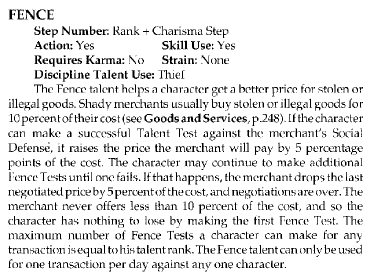
Yep, that's right. It's a Talent which lets you sell stuff. Man, everyone, I'm just loving this chapter.
Alright, sarcasm aside, I hate reading through lists of 3e D&D spells, 4e Powers, and, yes, Earthdawn talents. It's mind-numbing, and here, insanely oldschool and niche. What's more, some of the Talents are just dumb - especially ones for spellcasters. Take this one, for example (which admittedly has awesome art, but...)
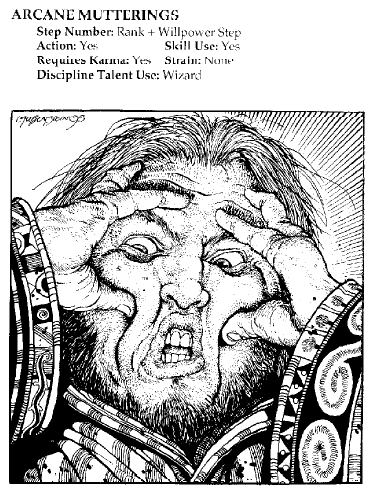
This is how I feel after reading this chapter.
This Talent lets your Wizard spout nonsense to intimidate people, and not really all that well. If you're a Wizard, you're probably stuck with it.

As far as I can tell, it seems like the designers ran out of good shit and more or less just put down whatever they could think of to fill out some circles. Some of it - like Fence - seems like stuff you should be able to do anyway, for free. Others, like Air Speaking ...
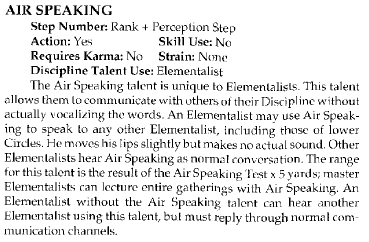
...are insanely niche . If this were on your Talent list, you'd rightly ask, "Why in the world am I spending Legend Points on a Talent I won't ever use in the course of a regular game?" I mean, it's not like you'll have five Elementalists in your party. And if you run into an Elementalist outside, it's not like it'll suddenly make the hundreds of Legend Points you sunk into this garbage Talent worthwhile. It's pretty well nonsense, and one of the few things I really don't like about Earthdawn.
On the other hand, some of the Talents are pretty awesome - maybe even brokenly so. Take Taunt, for example.
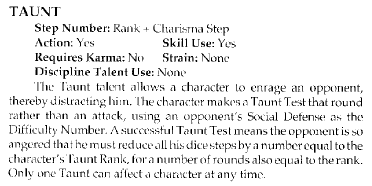
Frankly, this Talent is amazing. At 1 Rank, yeah, it kinda sucks. But at 8 Ranks? "Hey, sir, how about I mock you magically. You get to take -8 to all your Steps for 8 Rounds after I attack what's probably your weakest defense, k?" This has been toned down in 3rd Edition, of course.
Really, by and large, the non-casters get better Talents than casters. Which is IMO fine - it seems like some of the Talents should have been spells. I don't know if this is a balancing mechanism or they just ran out of ideas.
Alright, so here's some selections from the list. I'll mostly focus on the terrible ones.
Battle Shout and its big (though nearly indistinguishable cousin) Battle Bellow : Yell real loud at someone and scare them out of effectiveness for a round. Awesome for Sky Raiders. Hilarious on any Windling.
Book Memory and Book Recall : Kinda situational, but neat. You get to memorize a bunch of books. Once you "forget" them you might be able to call up more pages, later. (First book to memorize: The Earthdawn rulebook.)
Claw Shape and Claw Frenzy : Claw Shape lets your Beastmasters do insanely good damage, unarmed. Claw Frenzy was quickly errata'd, but it lets you make a shitload of attacks every round. Together, these are a Beastmaster's bread and butter.
Call Arrow : Get back a bunch of the arrows you fired. It's a 7th-Circle talent. Neat special effect, but really ? You're 7th Circle and you're spending a ton of Legend Points to save yourself 5 minutes of looking or a few silver pieces? The description even goes to great length to be sure you don't try to do anything cool with it; you get the arrow, and nothing else.
Creature Analysis : Ask the GM one question about an enemy's actual game stats. See what I mean about how there's no metagame in Earthdawn?
Dead Fall : Weird and niche. Use illusion magic to convincingly play dead. Please, may I dump Legend Points into it?
Disguise and Disguise Self : Also amazingly niche. How many times over the course of an average campaign do you don a disguise? It's one of those things that might sound awesome, but ... man.
Durability : It's all-important, and every Discipline gets it at 2nd Circle. Basically, this is how you improve your hit points. Every Discipline also has a different number - Warriors get 9 Death Rating/7 Unconsciousness Rating every Rank. Wizards get 4 Death/3 Unc. Swordmasters (and most every melee Discipline other than Warriors and Sky Raiders) get 7/6. I honestly don't understand why these differences are necessary... I suppose it makes some sense for casters to keep them off the front lines, but I don't get the impression that Warriors and Sky Raiders are otherwise shitty enough for the boost? It's another one of those areas where genre seems to have overruled balance. It's largely unchanged in 3rd edition, too.
Elemental Hold/Elemental Tongues : While I think Elementalists can summon Elementals, this seems like an awful lot of work for bullshit.
Engaging Banter : You force a target to engage you in witty banter. It slightly distracts them. You can use it in combat, but the effect is a lot weaker than something like Taunt and overall it's shit.
Fearsome Charge : Actually awesome, at least partly because of the picture.
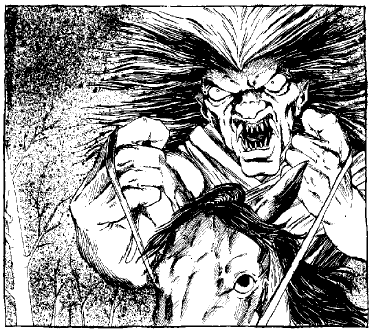
First Impression : This one isn't bad, but it illustrates something. Troubadours (and Swordsmen to a lesser extent) have about a half-dozen bullshit social interaction powers that imply a game much different from the one I normally run. I mean, unlike D&D and most trad-fantasy games, it takes its rather dumb NPC Reaction Tables very, very seriously. I don't know what I think about that; social interaction rules are fine if they're well-done. Maybe my impression will change when we get to that chapter... But right now, they seem like filler.
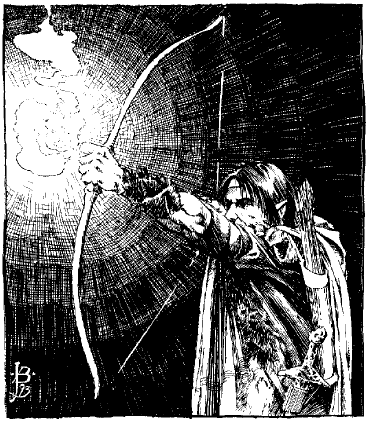
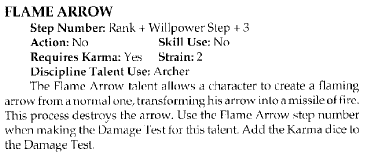
Flame Arrow : This Talent perfectly illustrates Earthdawn's "Yeah, it's cool, but did you do the math? " problems. (1) What, you didn't know your Archer needed Willpower? Loser! (2) It's still shitty! Let's look at Lars... He does Step 12 damage right now with his Sling. His Willpower Step is 5, so he needs to dump 5 Ranks into Flame Arrow until it's even with his normal, unmodified Elven Warbow (which he will have by then) damage - and then he gets to spend 2 Strain every time. Yes, he can use Karma on it - but he can do that with normal weapons by the time he hits 6th Circle. And really, by the time he gets to that point, he should have just woven some threads into a magic weapon or had his weaponsmith buddy Forge it up for him. (It's even crappier in 3rd edition, without that +3 in the Step formula, but it only takes 1 strain, and costs Karma.) Speaking of Forge Blade...
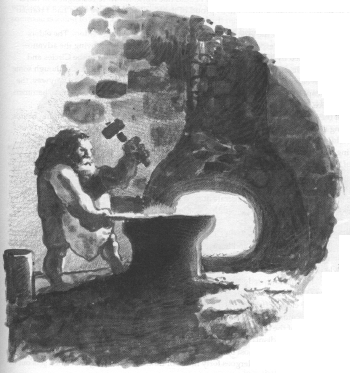
Forge Blade : Want to break Earthdawn's mechanics in half? This is how your Weaponsmith does it. It's time-consuming, but the end result is that you can make swords and other weapons do utterly insane damage. Let's say your Weaponsmith has 5 ranks in this; given enough time, you just got a +5 to your Damage Step. Does he have 7 Ranks in it? You got a +7.
Haggle : Really? This is a Talent?
Incite Mob and Incite Stampede : Useful when you need it, but how often will you need it??
Lock Pick : Kinda neat, actually. Because it's a Talent it makes a pick for you out of energy, and explicitly works against magical locks. Of course, it justifies Thieves as much as the social rules justify Troubadours, so...
Riposte : Another good one; a key Swordmaster Talent. Works to both evade a melee attack and possibly hit them back on a single die roll. Shit like this is where the Talent system is awesome. It's all the fucking filler .
Spirit Mount : Your Thundra Beast didn't fit in the Kaer? Well, conjure one.
Stopping Aim : An awesome Archer talent. Basically paralyzes someone you're aiming at. Not only stylish, but also effective and generally useful.
Temperature : I was going to make fun of this for being kind of niche, but I see the point, kinda? At high Ranks, at least. I mean, I think it's be awesome to lower a cold room by 50 degrees after casting Resist Cold on yourself.
Thread Weaving : I covered this a bit with Malzabar, but Thread Weaving is goddamn important for everyone. At its basic level, it lets you weave spell threads (for casters) and - crucially - activate and use Threaded Items like legendary artifacts and the more common sorts of weapons & such you find. Magicians get this at 1st Circle; everyone else needs to wait until 4th. This means your spellcasters will horde all the magic items for a few Circles. Suck it up, non-casters!
Trap Initiative : A weird one for Thieves and a few others. Again, niche, but maybe okay I guess? I think the goal should be to disarm traps (or um... fly over them, making its use maybe weird for Windlings?), but if you stumble onto one, this lets you react a bit more quickly to it.
Willforce : Wait for it... Wait for it...
Winning Smile : Yeah, the image was posted earlier, but... I will post the whole thing, for sake of

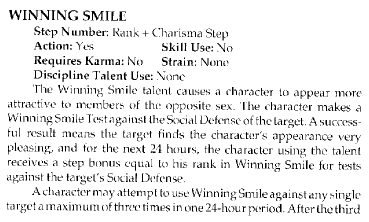
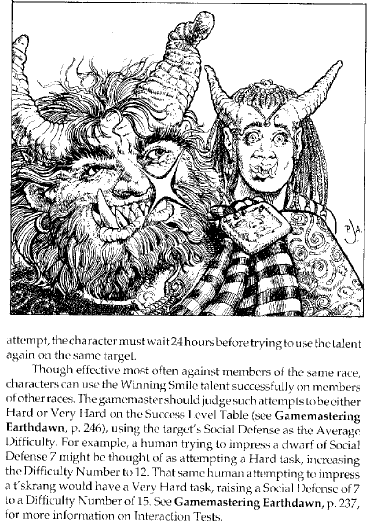
...and that's it for this installment, I think. My brain is hurt from the lists.
Closing thoughts... A lot of these are kinda fine, and might not seem really that bad. But remember - you improve these from the same pool of points you use for your really good stuff like making attack rolls, casting spells, improving your attributes, and buying Karma. And yet, you have to improve the shitty ones in many cases to advance your character. They're like feat taxes in D&D, only writ large.
Anyway! Next time, I'll (briefly?) cover some of the skills. And if Winning Smile made you
 , some of the skills will make you
, some of the skills will make you

Talents
Original SA post
Part 7: Talents!
Bonus DVD Commentary by Everything Counts
dwarf74 posted:
Really, by and large, the non-casters get better Talents than casters. Which is IMO fine - it seems like some of the Talents should have been spells. I don't know if this is a balancing mechanism or they just ran out of ideas.
Disguise and Disguise Self : Also amazingly niche. How many times over the course of an average campaign do you don a disguise? It's one of those things that might sound awesome, but ... man.
Engaging Banter : You force a target to engage you in witty banter. It slightly distracts them. You can use it in combat, but the effect is a lot weaker than something like Taunt and overall it's shit.
First Impression : This one isn't bad, but it illustrates something. Troubadours (and Swordsmen to a lesser extent) have about a half-dozen bullshit social interaction powers that imply a game much different from the one I normally run. I mean, unlike D&D and most trad-fantasy games, it takes its rather dumb NPC Reaction Tables very, very seriously. I don't know what I think about that; social interaction rules are fine if they're well-done. Maybe my impression will change when we get to that chapter... But right now, they seem like filler.
Haggle : Really? This is a Talent?
Incite Mob and Incite Stampede : Useful when you need it, but how often will you need it??
The more I think about it--and I've thought about it quite a bit as I have nothing else to do with my time
 --the more I think that some of these Talents are a legacy of
Earthdawn
being made as a prequel to
Shadowrun.
Shadowrun
also has 'adepts'--while not (usually) capable of casting spells, these characters had magic abilities that tended to enhance skills and attributes.
--the more I think that some of these Talents are a legacy of
Earthdawn
being made as a prequel to
Shadowrun.
Shadowrun
also has 'adepts'--while not (usually) capable of casting spells, these characters had magic abilities that tended to enhance skills and attributes.
Adepts in early editions of Shadowrun were usually combat-oriented--basically street samurai with magic instead of cyberware. But as the line went on, more abilities were created to reflect other 'paths' of adepts. These new adept powers allowed things like changing your appearance, winning at negotiations, bonding with animals or items... I haven't done a comparison between the games but I'd be willing to bet that a lot of Shadowrun powers that are reflected in Earthdawn.
Arcane Mutterings, though. I don't know what the hell that's about.
Skills
Original SA post
Part 8: Skills
Skills in Earthdawn are an odd sort of duck because it's an entire system, taking up quite a few pages, that most PCs (at least in 1st Edition) will barely interact with over the course of their careers. Sure, they have Knowledge skills and an Artisan skill and some stuff about languages - but no General skills to speak of. What's more, the game more or less throws barriers up to actively discourage players from using the system.
To upgrade a Talent, you pay a modest (but upward-scaling) Legend Point fee and meditate for a while. That's all - no training, no expenses, nothing but meditation and spending your experience.
To upgrade (or learn) a Skill, you need to pay a fee to a trainer, pay a lot more Legend Points, study for 1 week per Rank you're advancing to, AND practice for 1 month per Rank you're advancing to. (And this is considered fast, because Adepts are special.) What's more, you can't spend Karma on a skill and it doesn't count towards advancing you to a new Circle. It's a shit deal, all around.
So basically, Earthdawn 1e doesn't want you using Skills. Skills are mostly for NPCs and the truly desperate few Adepts who don't mind an XP and money sink.
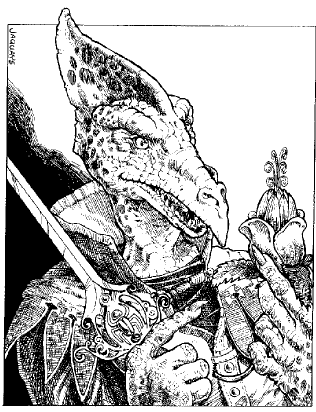
"What was I thinking spending 2,000 legend points on Botany?"
A good number of Talents are available as General Skills (that is, "skills you don't get for free, chump). There's a convenient list up front. The Second Attack/Second Weapon Skills I mentioned in my previous post can be found here (and honestly may not be a horrible deal if you can afford a few months of downtime).
And then we start on Knowledge skills, which Adepts actually have. Almost three freaking pages are devoted to an entirely too-complex system where it breaks down "related" vs. "unrelated" knowledge and it's really just too much bullshit to hide a plot point behind.
...and then we start on the General Skills that aren't also Talents. Some of them are reasonable - like Acrobatics, Tactics, Tracking, and Craftsman (which notably doesn't have an insane subsystem to go with it). However, a good number of these are absolutely terrible, so I'll take a break from being generally complimentary to crap all over this chapter, if you don't mind.
Let's start out with Artist. You'd think, "Roll a die; high rolls mean it's pretty." Nope.
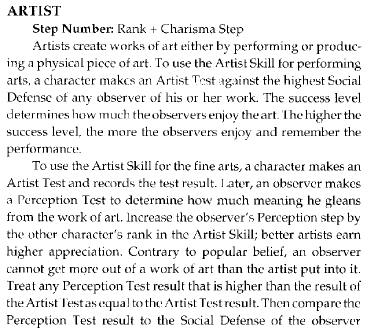
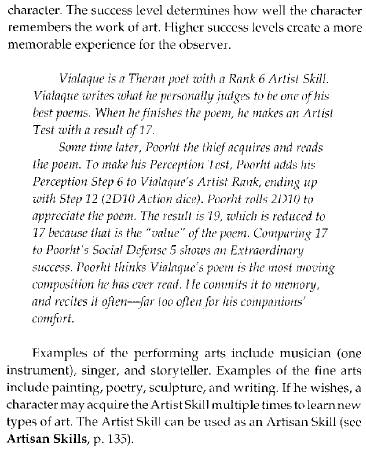
 So let's walk through this. I have Step 9 in Sculpture (3 Ranks). I roll Step 9 and end up with (say) 14. Anyone viewing my art adds my 3 Ranks to their Perception roll, but they can't roll higher than 14. If that is in turn higher than their own Social Defense, they will find it "memorable," because that was worth a few paragraphs of description. And smart people like art better. And you can't get any more out of a piece of art than the artist did because
So let's walk through this. I have Step 9 in Sculpture (3 Ranks). I roll Step 9 and end up with (say) 14. Anyone viewing my art adds my 3 Ranks to their Perception roll, but they can't roll higher than 14. If that is in turn higher than their own Social Defense, they will find it "memorable," because that was worth a few paragraphs of description. And smart people like art better. And you can't get any more out of a piece of art than the artist did because
But the stupid doesn't stop there. Oh gosh no. It gets worse.
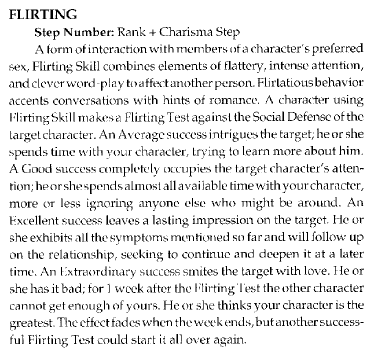
yes, of course there are rules for that.
Flirting! Yes, it's a skill. Yes, you need to learn it. And you're never attracted to anyone for longer than a week without repeated contact.
But that's not all, folks. If you are thinking, "Wow, trying to codify human relationships like this is a bit of a spergy thing to do - like that stupid Ladders thing, only in an RPG book, which I guess is redundant" well, we're not done! Let's take a very
 look at....
look at....
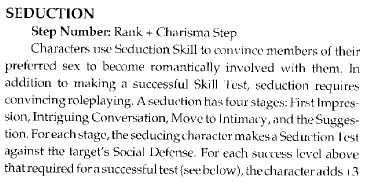
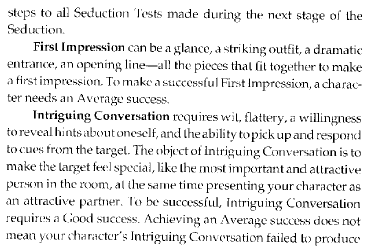
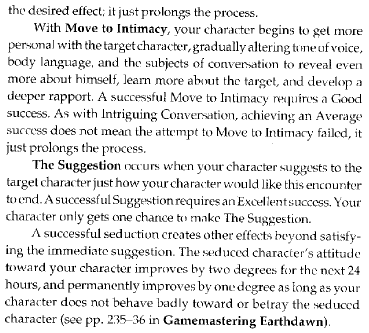
So these rules sound like fun! And it brings me to a question - can anyone in Earthdawn every have sex?
I am going to make a few assumptions here. First, that the Seduction skill can be used untrained, otherwise it's kind of weird everyone has it at 1 rank. Second, that we're using average humans instead of the more common dwarfs, both with Charisma 10. This gives them Step 5 Charisma (1d8) and a Social Defense of 6.
So who's with me?
Stage 1: First Impression Turgar the Farrier approaches Helga the Weaver in a Bartertown dive. He gives her a coy glance and comments about how nice she looks in her woven dress.
Turgar rolls 1d8 against a difficulty number of 6. There's only a 3-in-8 chance (37.5%) that we're going any further. Let's assume he makes the roll, so we can go to the next fun step.
Stage 2: Intriguing Conversation Turgar has Helga's attention and he starts making his move - making her feel special and important. "Helga, you are radiant, and also special and important. Look how attractive a partner I am! My farrier shop is a valuable asset you should consider!"
To succeed here he needs a Good result. On the chart all the way back on p. 246, we find he needs to roll a 10 on his 1d8. Not impossible given exploding dice. So he has a (1/8 * 7/8) chance, or right around an 11% chance of getting through this gate. Altogether, from the start, there's a 4.1% chance of getting past Stage 2 for poor Turgar.
Stage 3: Move to Intimacy Turgar puts his hand on Helga's wobbly knee and starts whispering sweet words into her ear over the clamor and tumult of the sweaty tavern.
He needs another Good result here to move past Stage 3. We already know that's about 11% (really 10.9%) likely. So, starting out from nothing, there's a 0.45% chance or so he's getting any further. Or, to put it another way, a 99.55% chance he's wasted his evening.
Stage 4: The Suggestion It's Turgar's lucky 1-in-200 night! Helga didn't run away screaming like the women from his last 199 attempts did! So he says, "You know, this bar is awfully hot. How about we go back to my farrier shop and do it on the horseshoes?"
For this to work, Turgar needs an Excellent success and he only gets one shot at this! Consulting the p.246 table, we know he needs a 13 on his 1d8 roll. Again - far from impossible. (1/8 * 1/2) or about a 6.25% chance for he and his weaver to make the beast with two backs if he made it this far in the first place.
Altogether, his odds of seducing Helga - an average sort of weaver, from a cold start - are about .028% Which makes it totally realistic for gamers who would use detailed rules for Seduction.
It is also why a 50-year-old farrier is still a virgin. And it proves everyone died out during the Scourge because nobody was banging anyone else. Q.E.D.

In summation, the Earthdawn skill rules are like your appendix - they serve very little purpose until one day you try to use it and it explodes and you end up in the hospital.
Next Up : Back to parts of the system I admire!
Magical Theory, Threads, Patterns, and Blood Magic
Original SA post
Part 9: Magical Theory, Threads, Patterns, and Blood Magic
So I had this 80% written and managed to lose my post. Sorry this took so long.
If you've been reading along, you already know that magic is a big deal in Earthdawn. After all - every character uses magic all the time, though sometimes the magic bits are just behind the scenes. This first chapter on magic (there's at least two) is devoted to magical theory and the sorts every Adept uses - Thread Magic and Blood Magic.
Earthdawn uses the Shadowrun cosmology where all magic comes from the astral plane. And, as we mentioned, the magic level rises and falls. Most of the time. When the magic level is in a trough, there's no magic and we get the mundane world we live in, without funny non-human races and without conveniences like airships, fireballs, etc. When the magic level peaks, horrifying astral beings come over from their netherworlds and shit up the world.
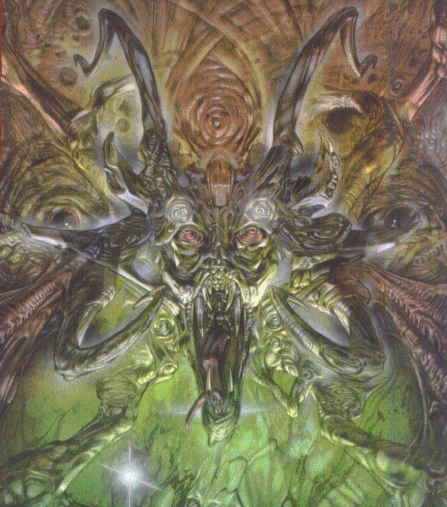
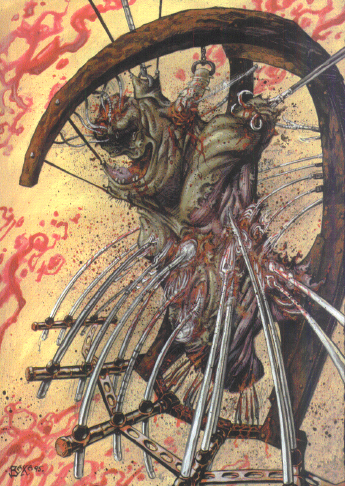
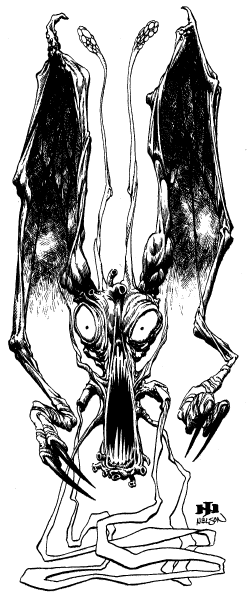
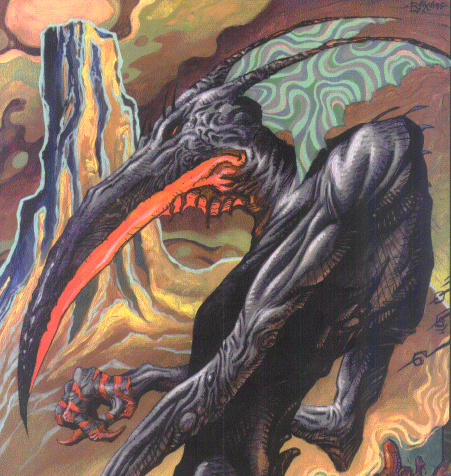
I'll take "low magic," thanks.
In theory, the magic level should have fallen by now. Incredibly, though, it stopped falling over a hundred years ago. Nobody's sure why (it's the Therans) but people think the world's magic level may have stabilized forever. (It won't - SPOILER!)
I mentioned the Astral plane up there. If you've ever played Shadowrun, that might have triggered some flashbacks, so I'm sorry about that. Between astral travel and "decking," Shadowrun more or less guaranteed the party would be split up and everyone would be sitting on their hands while a system was hacked or the astral plane was looted. Earthdawn avoids this by making the Astral a polluted hellhole. Any who dares travel there will probably either die in the process or get horror marked; the former is probably the preferable outcome.
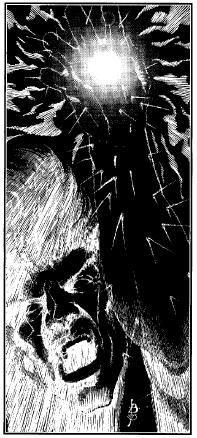
So the Therans (it's always the Therans) figured out ways to filter pure astral energy from the tainted black tendrils of corruption - spell matrices. We'll talk about those in due time.
But first, to explain the finer details of magical theory, we get an "excerpt" from a "book" "written" by "Jaron," you know the Sphinx guy from the history...
...This, by the way, is Earthdawn's absolute favorite conceit. Most every supplement released for Earthdawn 1e uses it to a fault - Denizens of Earthdawn I & II, The Adepts Way, Horrors, and Creatures of Barsaive (the goddamn monster book of all things!)at a minimum. You're not reading an RPG book. Oh heavens no. You're reading a compilation of material created by the scholar Merrox of the Hall of Records in Throal - a character your own characters might meet and chat with. He in turn presents interviews or correspondence straight from "experts" and dutifully records them in convenient RPG supplement form.
Anyway, as with all "excerpts" in RPG books, it's rather rudimentary for what'd no doubt be an erudite, scholarly topic... Every time I read something like this, I ask myself, "Why doesn't this read more like a journal article, medieval grimoire, or college-level text?" In other words, apart from maybe setting up an unreliable narrator, I don't think it adds anything because it's still transparently an RPG supplement written by RPG authors.
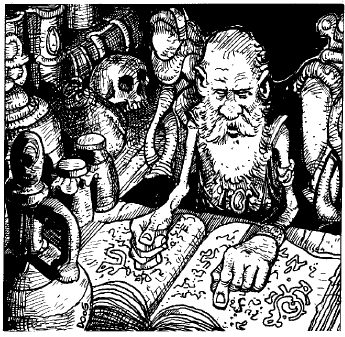
This picture of a guy reading a book is found in the fake book which is found in the actual RPG book. The book he is reading is the book you're reading now.
Now, with that said, it's a pretty good overview. Which is good, because this shit can get confusing.
Everything in the world has a Pattern. Most of these aren't unique; it's only when something is Named (by a Name-Giver race) that it becomes more important and might develop a True Pattern. True Patterns are a lot more important in the world, and can be interacted with via thread magic. Here's where it gets really weird.
In order to use thread magic to affect someone or something, you first need to know stuff about it - this is called "Pattern Knowledge." Pattern knowledge is made up of a bunch of "Key Knowledges"; some examples are a person's Name, their birthplace, favorite beer, etc. You also need one of their Pattern Items. Pattern Items are objects that have become important to something with a True Pattern, like a warrior's favorite weapon, a king's crown, or a drunk's favorite barstool. You can use the pattern item to learn Key Knowledges, but not all pattern items are created equal. There's Minor items, which are the most common and which tend to be incidental. Major pattern items are a lot more important. And Core pattern items are the really big ones - such as the king's crown, above. So basically, if you steal someone's chair, you can use it against them.
With that out of the way, let's talk about magic items.
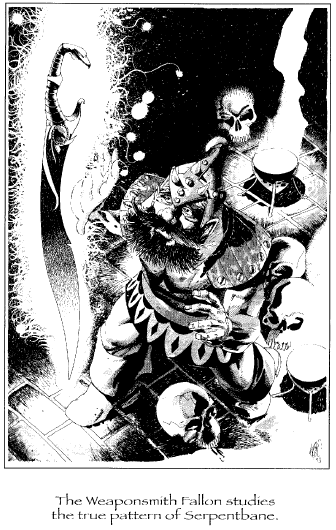
Earthdawn is downright innovative, here. It's not perfect, but like so much else in this damn game, it was groundbreaking for its time. You might hear from time to time someone complaining about some edition or another of D&D, saying that magic items have "lost their magic." Well, look no further. You will not find a +1 sword here, and any item you find will not just become central to your character, but will improve along with you.
Magic items in Earthdawn have True Patterns. They are, however, their own Pattern Items. In order to use a magic item, you need to weave a thread to their pattern. This is a multi-stage process, and it can be kind of a pain in the ass, especially if you're not a spellcaster. This will be easier with an example, so we'll use this one:
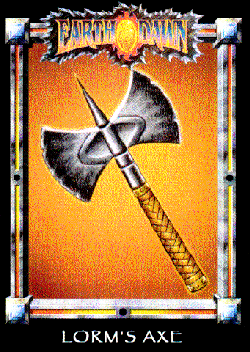
used by the badass troll in the intro story
Step 1: Get your friendly Weaponsmith, Troubadour, or maybe Wizard(?) to figure out what the item's Key Knowledge is. In this case (in every case, actually), you need to know the Axe's Name for Rank 1. This does't actually give you the knowledge - it's like magic item Jeopardy. It just tells you the right thing to research.
Step 2: Research or quest for the information. Perform a Deed if you need to.
Step 3: Spend Legend Points and roll your Thread Weaving.
Step 4: Enjoy the new shiny! In this case, your 100 Legend Points will make the axe hit harder; always a worthy goal.
As you get better, you can also weave better Threads to Lorm's Axe. To get Rank 2, you will need to finish a Deed; here it's "hurt a Horror." You know, like in the story! That will make the axe hit even harder. Then you need to find the Name of the weaponsmith who made it. That will improve your Physical Defense. And so on... You're still spending Legend Points, but it's not in a way you could normally do it, and it's generally a bargain compared to (say) improving your Strength.
It's pretty clever, once you get past two major hurdles.
(1) You're still spending your own Legend Points instead of improving your abilities. If you didn't like the idea of spending XP to create magic items, you might balk at the idea of spending XP to use magic items.
(2) Unless you're a spellcaster or a human who's picked up some tricks via Versatility, you can't use any magic items until you're Fourth Circle. Which is a bummer.
So that's all we have here about thread magic. If you want your mind broken, I can go into the crazy-ass thread weaving shit like Group Patterns and whatnot in another post. It's nearly impossible to explain.
Let's talk really briefly about blood magic.
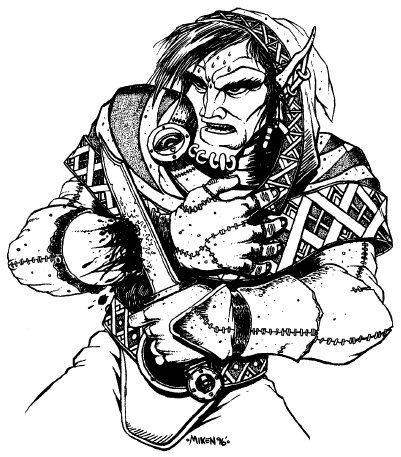
ouch
More or less, blood magic is cybernetics, fantasy-style. I detailed them a bit before, but ... You take "permanent damage" to use blood magic items. Sometimes this really is permanent, like if you replace one of your eyes with an astral-sensitive gemstone or one of your arms with a crystal replacement. Sometimes it's kinda-sorta permanent, like to power a magic charm.
Again - magic tends to have a cost in Earthdawn. This is another side of it.
People tend to be sketchy around blood magic. Most of the populace considers it kind of creepy and/or wrong. It doesn't stop it from being popular though, and most every Adept will use it at one point or another.
And this has gone on quite long enough. Next time: Spell Magic
Spell Magic Mechanics
Original SA post
The (long-delayed) Part 10a: Spell Magic Mechanics
Sorry for the gap, folks, but between working on the game I'm actually playing and traveling altogether too much on the holidays, I'm back in business!
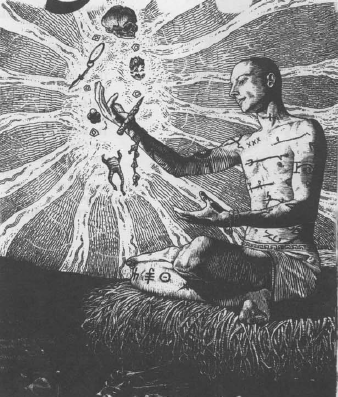
Spell Magic in Earthdawn gets a lot of accolades, and it's not hard to see why. It's clever. It has in-setting explanations for its weird tropes. It's flexible. And (in theory) it's in line with the rest of the system. We'll see on that last bit, but it's undeniably cool. There's four spellcasting classes - Elementalists, Illusionists, Nethermancers, and Wizards. Their spell lists will get a good once-over, but they all work exactly the same. For our purposes, we'll use Malzabar the Magnificent , Wizard and Elementalist.
If you remember back in my last write-up , magic is all about threads. But while spell magic uses many of the same terms, it's completely different in every way from more orthodox thread magic. Just to, you know, make everything confusing. As I mentioned there, astral space is a fucking cesspool thanks to all the Horrors shitting it up. Because of this, channeling raw astral energy is extremely interesting and exciting. For one thing, you might explode. For another, if you don't explode, you could get a new best friend in a Horror who decides to mark you and torment you forever and if they do, there's nothing you can do about it short of trying to kill them, which will be hard considering they've claimed you as their own.
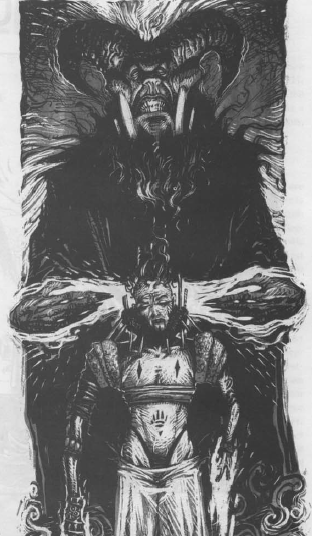
One of the milder consequences of casting raw magic
So yeah. Raw Magic is one of those red buttons in Earthdawn with a big shiny "DO NOT PRESS" sticker. It's incredibly dangerous to both body and soul, but it's undeniably powerful. Have you ever wondered why your Wizard couldn't cast, like, any spell in the book? Well, with Raw Magic he can, and suffer in the process!
So most casters opt for something saner - Matrix Casting. (There's also grimoire casting, but it's kinda boring.)

No, the other Matrix
If you check Malzabar's sheet, you'll notice he has two Spell Matrices, both at Rank 1. (And yes, I know he's an ED 3rd Edition character; there's very little difference at this Circle.) Each Spell Matrix is an astral construct; kind of an empty loom hovering around your character. Each matrix can hold a spell pattern; from there, the magician can cast it with just a fairly small exercise of will. (Some spells are more complex - more on these in a bit.) You can't hold a spell in a matrix, unless (1) the Circle of the spell is equal to or lower than the Spell Matrix's rank, and (2) you are of a Circle at least equal to the Circle of the spell. Both pretty logical.
So Malzabar can prepare two Circle 1 spells in his matrices. He can reattune these to any other spell he knows
Spellcasting itself is a breeze - and, again, more like a precursor to 4e D&D than a relative of AD&D. To successfully cast a spell, you weave any required threads and make a Spellcasting roll. Yep, that's right - you can cast spells at-will, but you need to roll to succeed on them, going against your target's Spell Defense (or a static number if you're not casting it on someone). Yes, this includes your allies - in the heat of battle, you need to beat their Spell Defense to cast good spells on them. (You can cast spells on yourself no problem, but even then, enemies get a bonus to attack you with magic this round.)
Let's look at Mind Dagger again.

Mind Dagger is an insanely simple spell. Threads: None means he can cast it every round, as opposed to another example we'll get to soon. The Weaving Difficulty has "NA" before the slash, because ... well, no threads. After the slash is the "reattuning difficulty" which is how tough it is to ready this spell if you don't have it prepared (more on this soon, too). Range and Duration are self-explanatory. Effect: Willforce +2 is (as you can see from the spell description) the amount of damage done by the spell. Willforce is a Fifth-Circle talent that lets spellcasters bend the game over their knee and spank it in 1st edition. A 1st-Circle Wizard doesn't have it yet, so we default to Willpower.
Let's have an example...
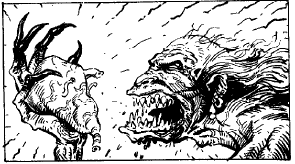
In his adventures, Malzabar runs across a Ghoul. Ghouls are pretty easy monsters, all things considered, so Malzabar tries to zap it with his Mind Dagger. His Spellcasting Step is 8, so he rolls 2d6; if he spends his awesome Human Karma, he can toss 1d8 on top of it. Ghouls have a Spell Defense of 5. He rolls ... a 6 and a 3! The 6 explodes, being Earthdawn, and he gets a 5. So his total is 14, which is more than enough for an Excellent success against the Ghoul. (Yes, spells score armor-defeating hits just like weapons do.) This would be awesome if the Ghoul's Mystic Armor weren't already 0; as it stands, Malzabar just earns style points.
The Effect Step is Willpower+2, or Step 9. That's a d8+d6. He rolls a 4 on the d8, and ... wow, another 6 on the d6, which is a 4 on the re-roll. So all told, he does 14 damage. That's ... not a ton, really, considering he'll need 36 damage total to stop the Ghoul, but it's a Wound. This can knock the ghoul down; we'll say it does (and go into this more in a later post) to give Malzabar a chance to survive.
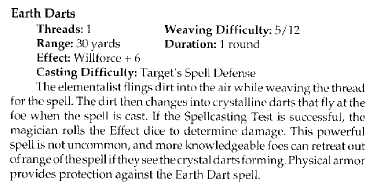
So Malzabar runs back a bit and decides he needs to bring out the bigger guns. Dispel Magic will do jack and shit here, so he decides he needs to cast Earth Darts, one of the Elementalist spells he knows. Problem is, he doesn't have it prepared. He can do one of two things here - cast it Raw or reattune one of his matrices "on the fly."
We'll do this both ways, for fun. But first we hit

If Malzabar is an idiot, he casts it Raw. Ghouls, being Horror-created, are a pretty positive sign there's been a Horror around lately, so this is incredibly dumb. Astral Space hereabouts is ... let's say it's Corrupt, to inflict maximum fatality; that's basically the worst-possible case.
Raw Casting starts out a lot like regular casting. Unlike Mind Dagger, though Earth Darts requires 1 Thread. This means it takes an extra round and an extra roll to cast. His Elementalism is Step 8 (2d6); referencing the Earth Darts spell, it has a Weaving Difficulty of 5. He wastes a round not-killing the Ghoul, rolls a 6, and continues trying not to die. Next round, he gets to roll Spellcasting again; he can spend Karma just like normal, and does. Spellcasting is (also) 2d6, but this time with an added 1d8. He gets a 6/6, 1/8, and 4/6, so his d6 explodes again. Another 6. A third roll of that die is a 3. So, all told, he rolled a 20. Again, easily an armor-defeating hit, which is good considering Earth Darts goes against physical armor. It deals Will+6, or Step 13 (d12+d10) damage. And he's exploding like crazy tonight; get gets a 10/10 and 3/12; re-rolling the d10 gets a 7, for a total of 20 damage. Impressive, and another Wound, but still 2 short of killing it (wah wah wahhhhh)
But... this was cast Raw in a Corrupt area. He now gets to die horribly. First, we check for Warping, also known as "burning the shit out of your soul, you moron." It "attacks" him at Circle + 15 (Step 16, an obnoxious d20+d8) vs. his Spell Defense of 9. I roll a 17, 1 shy of armor-defeating. So now it does damage, this time Circle + 16 (Step 17, d20+d10). Poor Malzabar takes 25 damage, reduced by 2 for his Mystic Armor means he's taken a Wound and is 2 away from unconsciousness. Also, to make matters worse, I roll Step 16 against Malzabar's Spell Defense again... and get a 24. So hooray - Malzabar is now Horror Marked and will be fucked over by the GM for the rest of his career.

Hello. We'll be spending a lot of time together...
...so let's F9 our saved game, and let Malzabar Reattune On the Fly instead of doing the dumbest possible thing.
The problem is, this takes another round he'd probably be better off Mind Daggering, but this is for illustration purposes. See that "12" after the slash in Earth Darts? He needs to spend a round Reattuning and a point of Strain, and then needs to roll that number on his Elementalism step of ... 8 (2d6). Again, this is while a ghoul is trying to eat his face. Not too crazy with exploding dice, but too damn unlikely for Malzabar's tastes. And he can't spend Karma on it, since it's not a Discipline Talent. As it stands, he decides he's better off with Mind Dagger (and he seriously is), in every single way.
So that's how magic works. Really innovative, connected with the rest of the game's mechanics, and altogether not (at this stage) overpowered compared to hacking shit to death with big swords. In fact, I'd argue it's a little worse, right now. This will change...
Next Time: Spells! What can I cast? What does it do?